User Manual
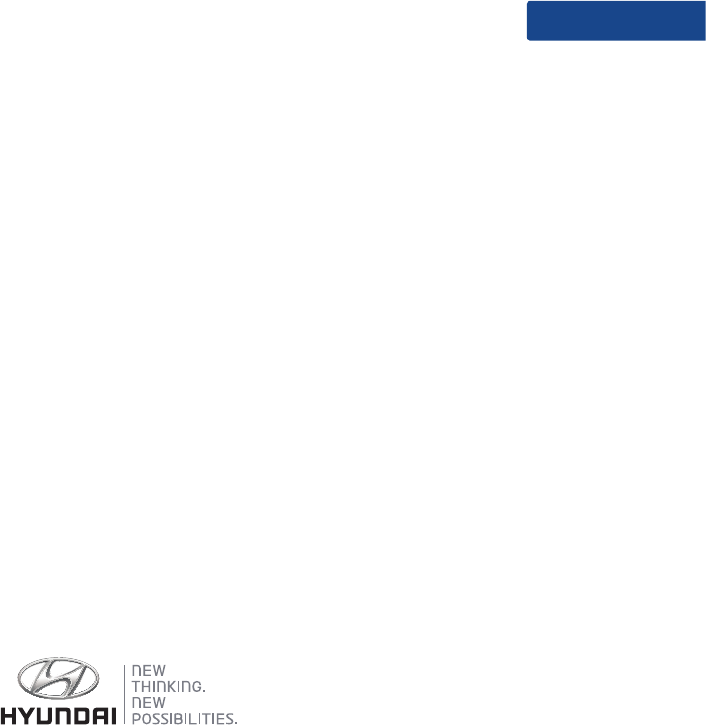
CAR MULTIMEDIA SYSTEM
USER’S MANUAL
CRETA
Please read this manual carefully before operating your set and retain it for future reference. Designs and specifica-
tions are subject to change without prior notice.
The screens shown in this manual may differ from the actual screens of the product.
The design and specification of this product may change without prior notification for product improvement.
When transferring the vehicle to another individual, include this user’s manual so that the next driver can continue its use.
ENGLISH
Rev.2.0
iPod®
iPod® is a registered trademark of Apple Inc.
Bluetooth®
The Bluetooth Wireless Technology word mark and logos are registered
trademarks owned by Bluetooth Wireless Technology SIG, Inc.
DOLBY
Manufactured under license from Dolby Laboratories “Dolby” and the double-D
symbol are trademarks of Dolby Laboratories
Cortex
Cortex is the name of the ARM Processor Architecture used in the AV System.
Windows Embedded Compact 7
Windows Embedded Compact 7 is an operating system used in the AV
System.

3
Table of Contents
ENGLISH
Precautions for safety
Safety notes
6
Key Product Features
Key Product Features
8
Component Names and Functions
Head Unit
9
Steering Wheel
11
Using the System for the First Time
Turning the System On/Off
12
Turning the System ON
12
Turning the System Off
12
AV ON/OFF
12
Resetting the System
12
FM/AM
Basic Screen
13
Listening to FM/AM radio
14
Auto tuning
14
Manual tuning
14
Selecting Presets
14
Selecting Lists
14
Saving Radio Frequency
15
Saving Manually
15
Using Preset Menu
15
Scan
15
Scanning Radio Frequency
15
Scanning Preset frequency
15
Sound settings
15
USB
About USB
16
USB Music
Playing USB Music
17
Searching USB Music Files
17
Repeat
17
Shuffle
17
Scan All
17
Scan Folder
17
Album Cover view
18
List
18
Sound settings
18
USB Video
Playing USB Video
19
Searching USB Video Files
19
Repeat
19
Shuffle
19
List
20
Caption
20
Display settings
20
Sound settings
20
USB Photo
Viewing USB Photo
21
Switching to menu screen or full screen
21
Searching USB Image Files
21
Rotating / Slide show
21
Using the Menu Buttons
22
Slideshow interval
22
Display settings
22
iPod Music
About iPod
23
Supported iPod devices
23
Playing iPod Music
24
Searching iPod Music Files
24

4
Table of Contents
Using the Menu Buttons
24
Setting audiobook playback speed
24
Sound settings
24
AUX
Playing an AUX source
25
Using the Menu Buttons
25
Bluetooth Audio
Before playing the Bluetooth audio
26
Searching Bluetooth audio Files
26
Searching USB Music Files
26
Using the Menu Buttons
26
Getting started with navigation
Precautions for safe driving
27
What is GNSS?
27
About satellite signals
27
Acquiring satellite signals
27
(Refer to the separate navigation manual
for more detailed operation)
Bluetooth® Wireless Technology
Before Using the Bluetooth Handsfree
28
What is Bluetooth® Wireless Technology?
28
Precautions for Safe Driving
28
Cautions upon Connecting Bluetooth Phone
28
Bluetooth Connection
When no Phones Have Been Paired
29
Pairing from the Bluetooth® Device
29
Pairing from the car
29
When a Phone is Already Paired
30
When your phone is connected
30
Bluetooth Phone
Making/Answering Calls
31
Calling by Dialing a Number
31
Making a Call from Speed Dial
31
Calling through Redial
31
Answering a Call
31
Rejecting a Call
31
Operating Menus during a Call
32
Ending a Call
32
Switching Call to Bluetooth® Phone
32
Making 3 way call
32
Using the Menu Buttons
33
Contacts
33
Updating Mobile Phone Contacts
33
Making a call from contacts
33
Searching for contacts
33
Calling list
34
Viewing Calling lists
34
Favourites
34
Calling Favourites
34
Saving to Favourite
34
Deleting Favourites
35
Changing the Favourites name
35
Bluetooth settings
35
Setup
Starting mode
36
Sound
36
Sound Balance
36
Variable EQ
36
Volume setting
36
Beep
37
Display
37
Brightness
37
Dimming mode
38

5
Table of Contents
ENGLISH
Bluetooth settings
38
Bluetooth connection
38
Ringtone
39
Change passkey
39
Changing device name
39
Auto Connection
40
System
40
Language
40
Keyboard
40
Standby screen
41
Factory settings
41
Specification
USB MP3 Specification
42
Video and Image Specification
42
Before thinking there is a product
defect
Before thinking there is a product defect
43
Trouble shooting
Trouble shooting
44
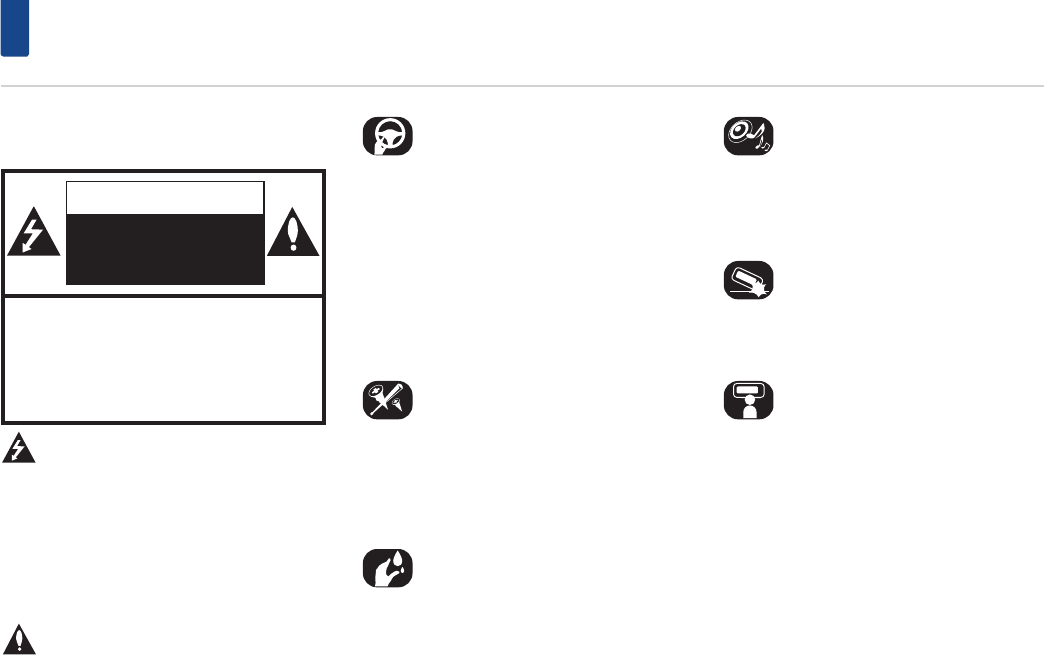
6
Precautions for safety
Safety notes
CAUTION
RISK OF ELECTRIC
SHOCK
DO NOT OPEN
CAUTION: TO REDUCE THE RISK OF
ELECTRIC SHOCK, DO NOT REMOVE THE
COVER (OR BACK). NO USER SERVICEABLE
PARTS INSIDE. REFER SERVICING TO
QUALIFIED SERVICE PERSONNEL.
The lightning flash with the arrowhead symbol
within an equilateral triangle is intended
to alert the user about the presence of uninsu-
lated dangerous voltage within the product’s
enclosure that may be of sufficient magnitude to
constitute a risk of electric shock.
The exclamation point within an equilateral tri-
angle is intended to alert the user to
the presence of important operating and main-
tenance (servicing) instructions in the literature
accompanying the appliance.
Always operate the vehicle in a safe manner. Do
not become distracted by the vehicle while driv-
ing and always be fully aware of all driving condi-
tions. Do not change settings or any functions.
Pull over in a safe and legal manner before
attempting such operations.
To promote safety, certain functions are disabled
unless the hand brake is on.
To reduce the risk of electric shock, do not
remove the cover or back of this product. There
are no user-serviceable parts inside.
Refer servicing to qualified service personnel.
To reduce the risk of fire or electric shock, do not
expose this product to dripping or splashing
water, rain, or moisture.
When driving your vehicle, be sure to keep the
volume of the unit low enough to allow you to
hear sounds coming from the outside.
Do not drop it and avoid heavy impacts at any-
time.
The driver should not watch the monitor while
driving. If the driver watches the monitor while
driving, it may lead to carelessness and cause an
accident.

7
Precautions for safety
ENGLISH
WARNING:
••Do not stare at the screen while driving. Staring
at the screen for prolonged periods of time
could lead to traffic accidents.
••Do not disassemble, assemble, or modify the
navigation system. Such acts could result in
accidents, fire, or electric shock.
••Using phone features while driving may distract
drivers from paying attention to traffic condi-
tions and result in traffic accidents.
Use phone features only after the vehicle has
been parked.
••Heed caution not to spill water or introduce
foreign objects into the device. Such acts could
lead to smoke, fire, or product malfunction.
••Please refrain from use if the screen is blank
or no sound can be heard as these signs may
indicate product malfunction. Continued use in
such conditions could lead to accidents (fires,
electric shock) or product malfunctions.
••Do not touch the antenna during thunder or
lightening as such acts may lead to lightning
induced electric shock.
••Do not stop or park in parking-restricted areas
to operate the product. Such acts could lead to
traffic accidents.
••The video screen will not operate when the
vehicle is in motion. For your safety, first park
the vehicle to watch or view the screen.
••Some Non-video features may also not operate
when the vehicle is in motion. These features
will operate only when the vehicle has been
parked.
CAUTION:
•
•Do not keep the
navigation
system running
with the engine stopped. Doing so may dis-
charge the vehicle battery. When you use the
navigation
system, always keep the engine
running.
•
•When the driver wants to operate
navigation
system, first park the vehicle in a safe location
and set the parking brake.
Operating the system while driving can dis-
tract the driver and may result in a serious
accident.
•
•Do not disassemble or modify this system. If
you do, it may result in accidents, fire, or elec-
trical shock.
•
•Some states/provinces may have laws limiting
the use of video screens while driving. Use the
system only where it is legal to do so.
•
•Do not use your phone in private mode when
you are driving. You must stop at a safe loca-
tion to use it.
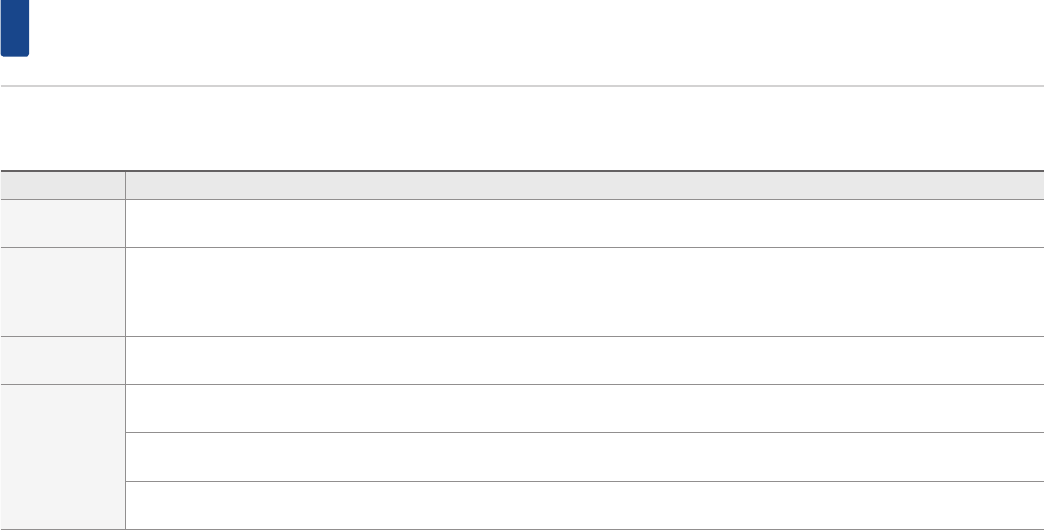
8
Key Product Features
Key Product Features
Name Description
Display Wide TFT-LCD Display
Provides high quality video through a Wide TFT-LCD Display using an LED Back Light.
Radio
Digital Tuner Feature
Digital Tuner using PPL method that supports memory of 20 broadcast stations for each AM and FM modes.
Radio broadcast station name
Displays broadcast station names for key locations.
Multimedia
Player
Support for various Media Formats
Support for various media formats, including Radio, MP3, USB, iPod, AUX and Bluetooth® Audio Streaming modes.
Miscellaneous
Bluetooth
®
Wireless Technology
Convenient use of Bluetooth® Handsfree by using buttons within the steering wheel remote controller.
Digital Screen Control Features
Easy control of features through touch screen options.
Steering Wheel Remote Controller
Control over audio features and Bluetooth® through the steering wheel remote controller for maximum convenience.
C
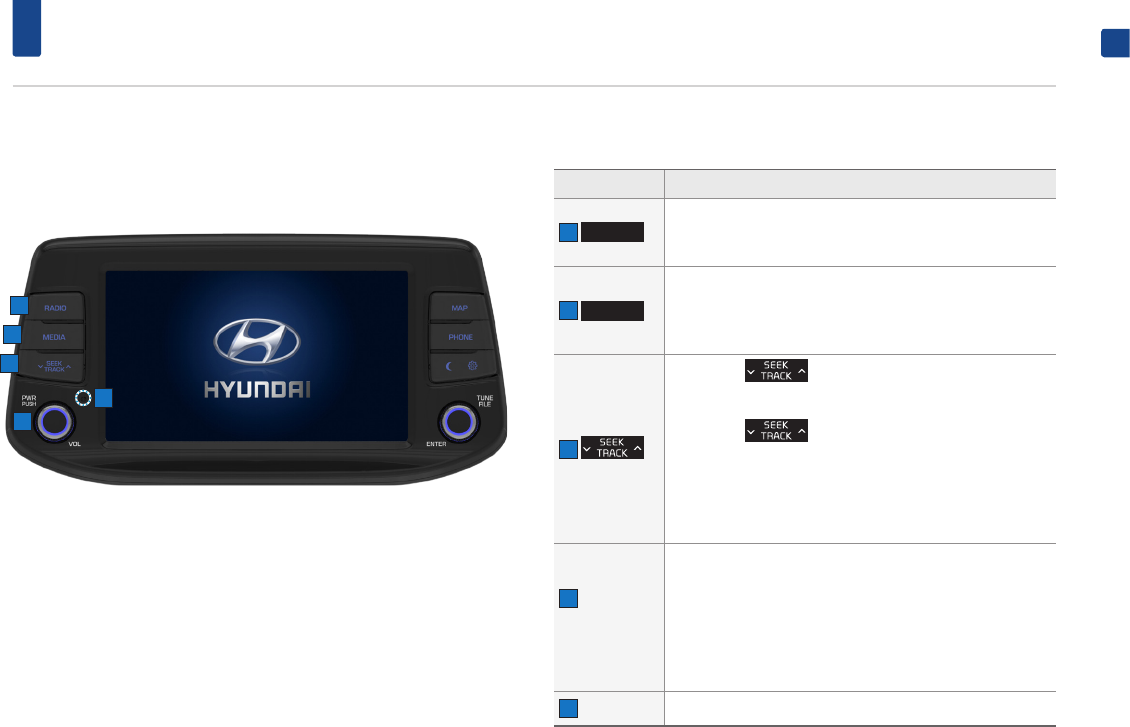
9
Component Names and Functions
ENGLISH
Head Unit
Name Description
1
RADIO
••Operates FM/AM mode.
••Each time the key is pressed, mode is changed in order
of FM ▶ AM ▶ FM.
2
MEDIA
••Operates available media (USB, iPod, Bluetooth Audio,
AUX).
••If the media is not connected, corresponding modes will
be disabled.
3
When the keys are pressed shortly.
••In FM/AM mode, searches broadcast frequencies.
••In Media modes, changes the track, file or chapter.
When the keys are pressed and held.
••FM/AM mode : automatically searches broadcast fre-
quencies and channels. Once released, searches and
begins playing the next broadcast frequency.
••Media modes: rewinds or fast forwards the track or file
(except AUX).
5 Power /
Volume
Knob
••Power on
When power is off, press to turn power on.
••Power off
When power is on, press and hold to turn power off.
••Audio off
When power is on, press to turn Audio off.
••Turn left/right to control volume.
6 Reset Resets the system.
2
3
1
4
5
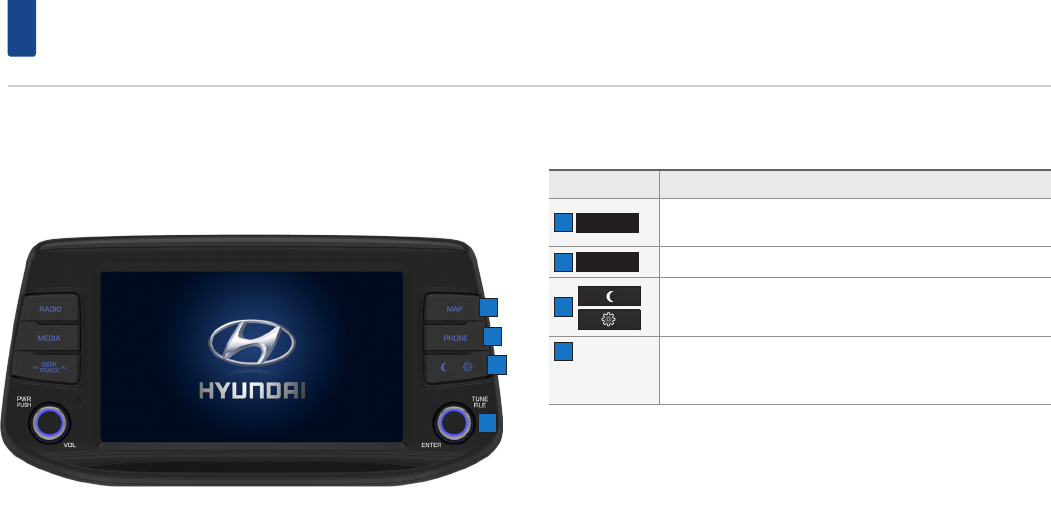
10
Component Names and Functions
Name Description
6
MAP
Press to display the map screen of the current location
when in a different mode.
7
PHONE
Takes user to phone screen.
8 ••Turns off the screen.
••Displays the Setup mode.
9 Tune /
ENTER
Knob
•
•FM/AM mode : changes the frequency.
•
•MEDIA (USB/iPod) mode : changes the track, file or title
(except AUX).
Head Unit
6
7
8
9
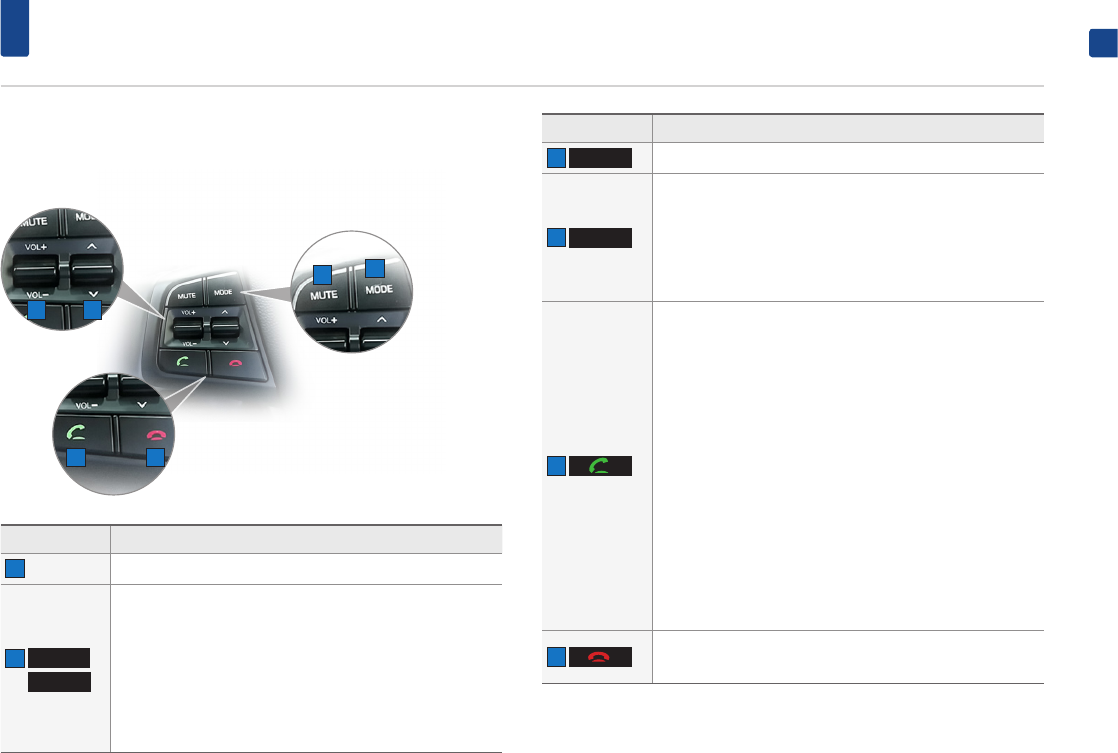
11
Component Names and Functions
ENGLISH
Steering Wheel
Name Description
1 + VOL - Controls the volume.
2
∧
∨
When keys are pressed shortly.
••FM/AM mode: scans and receives the previous/next fre-
quency.
••Media mode: changes the track, file or chapter.
When keys are pressed and held.
••In FM/AM mode: changes frequencies while pressed.
Upon release, scans and receives the next frequency.
••Media mode: rewinds or fast forwards the track or file.
Name Description
3
MUTE
Mutes the sound.
4
MODE
••Operates FM ▶ AM ▶ Available Media (USB Music/USB
Video/iPod/Bluetooth Audio/AUX).
••If the media is not connected, corresponding modes will
be disabled.
••Press and hold the key to turn the Audio system on/off.
••When power is off, press the key to turn power back on.
5
When pressed shortly.
••When pressed in the phone screen, displays the last call.
••When pressed in the dial screen, makes a call.
••When pressed in the incoming call screen, answers the
call.
••When pressed during single call, switches call back to
mobile phone (Private).
••When pressed during 3way call, swap call.
••When pressed twice, redials the last call.
When pressed and held.
••When pressed during a Bluetooth® Handsfree call,
switches call back to mobile phone (Private).
••When pressed while calling on the mobile phone,
switches call back to Bluetooth® Handsfree (Operates
only when Bluetooth® Handsfree is connected).
••When pressed, redials the last call.
6 •
•When pressed during a call, ends the phone call.
•
•When pressed in the incoming call screen, rejects the call.
1 2
34
5 6
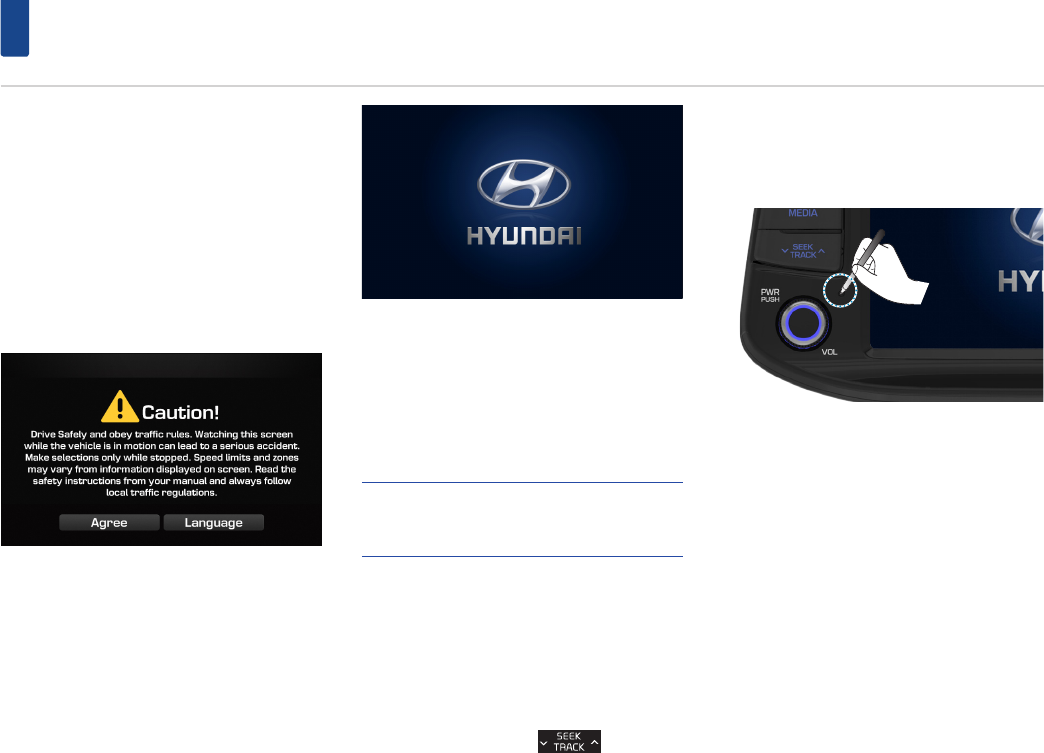
12
Using the System for the First Time
Turning the System On/Off
Turning the System ON
Press the engine start button. If the brakes are
not pressed, then the ACC and system will turn
on. If the brakes are pressed, then the IGN and
system will turn on and the ignition will start. In
both instances, the following safety warning will
be displayed.
Pressing the PWR key on the head unit will dis-
play the safety warning page.
Press the Agree button to display the most
recent mode.
Turning the System Off
Press the engine start button again or press and
hold the power key on the head unit to turn the
system off.
NOTE
• If the system is turned off while the Handsfree is
being used, then the call will automatically switch
back to the mobile phone.
AV ON/OFF
Press the PWR key on the head unit when the AV
is on. Press the PWR key or press the menu key
to turn on AV.
While AV is turned off, the key and the
TUNE / ENTER knob will be disabled.
Resetting the System
This feature is used to reset the system in the
occurrence of an unforeseen error or problem.
Press and hold the RESET key for about 1 second.
(The use of a clip or pin is recommended when
resetting the system.)
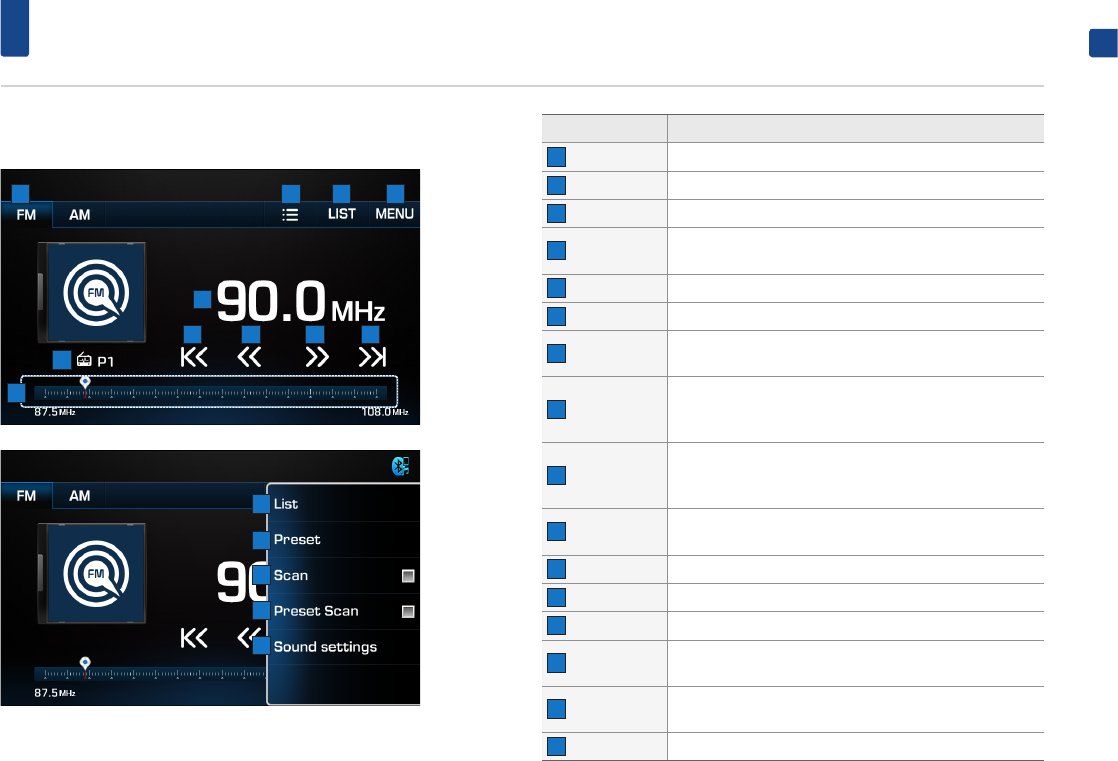
13
FM/AM
ENGLISH
Basic Screen
Name Description
1 Mode tap Press the tab to change between FM and AM mode.
2 Preset button Displays the Preset List.
3 List button Displays automatically updated lists.
4 Menu button Displays List, Preset, Scan, Preset scan and Sound settings
menus.
5 Frequency Displays the current frequency.
6 Preset No. Displays the current preset number.
7 Seek down Single tap: seek down.
Long tap: fast seek down.
8 Tune down
Single tap : tune down.
Long tap: tune down until the button is released and
plays the current frequency.
9 Tune up
Single tap : tune up.
Long tap: tune up until the button is released and plays
the current frequency.
10 Tune down Single tap: seek up.
Long tap: fast seek up.
11 Frequency bar Use the tap to move to the desired frequency.
12 List Displays automatically updated lists.
13 Preset Displays saved presets for user selection.
14 Scan Plays frequencies with superior reception for 3 seconds
each.
15 Preset Scan Plays frequencies saved to presets for 3 seconds and
moves to the next saved frequency.
16 Sound settings Sets sound related settings.
21 3 4
97 8 10
6
5
11
12
13
14
15
16
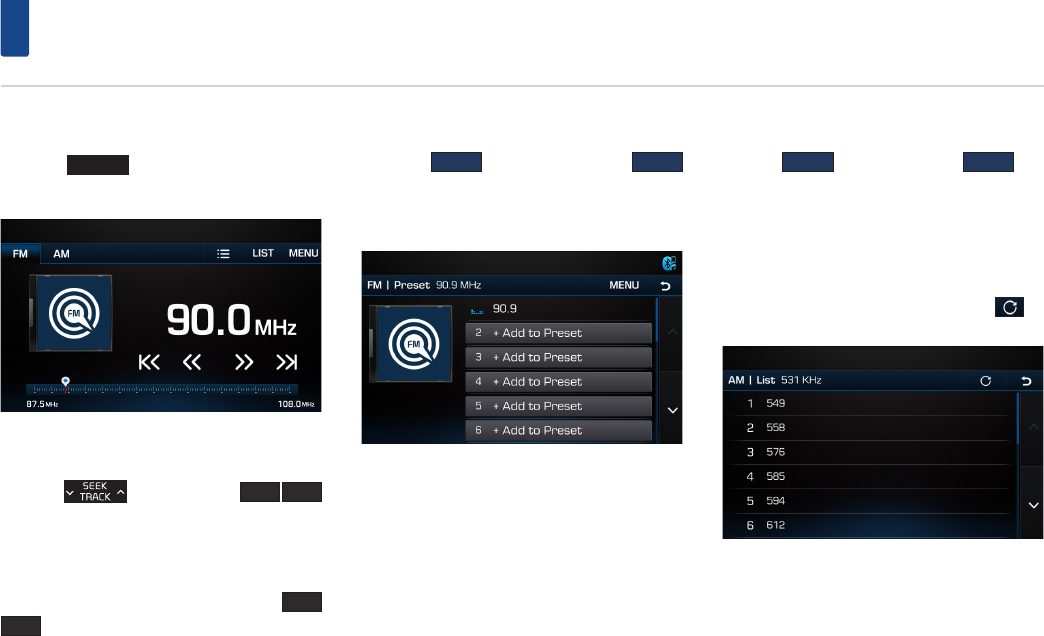
14
FM/AM
Listening to FM/AM radio
Press the
FM/AM
key to change the mode in
order of FM ▶ AM ▶ FM.
Auto tuning
Press the key or press the
l<<
>>l
button to automatically search for frequencies.
Manual tuning
Press the TUNE / ENTER knob or press the
<<
>>
button to manually select the frequency.
The stations move up and down step by step.
Press the frequency bar to search for frequencies
that you want.
Selecting Presets
Press the
MENU
button ▶ Press the
Preset
button. From the presets, select the frequency
you want to listen to.
Selecting Lists
Press the
MENU
button
▶
Press the
List
but-
ton.
From the lists, select the frequency you want to
listen to.
FM lists are automatically updated.
AM lists are manually updated by pressing ( ).
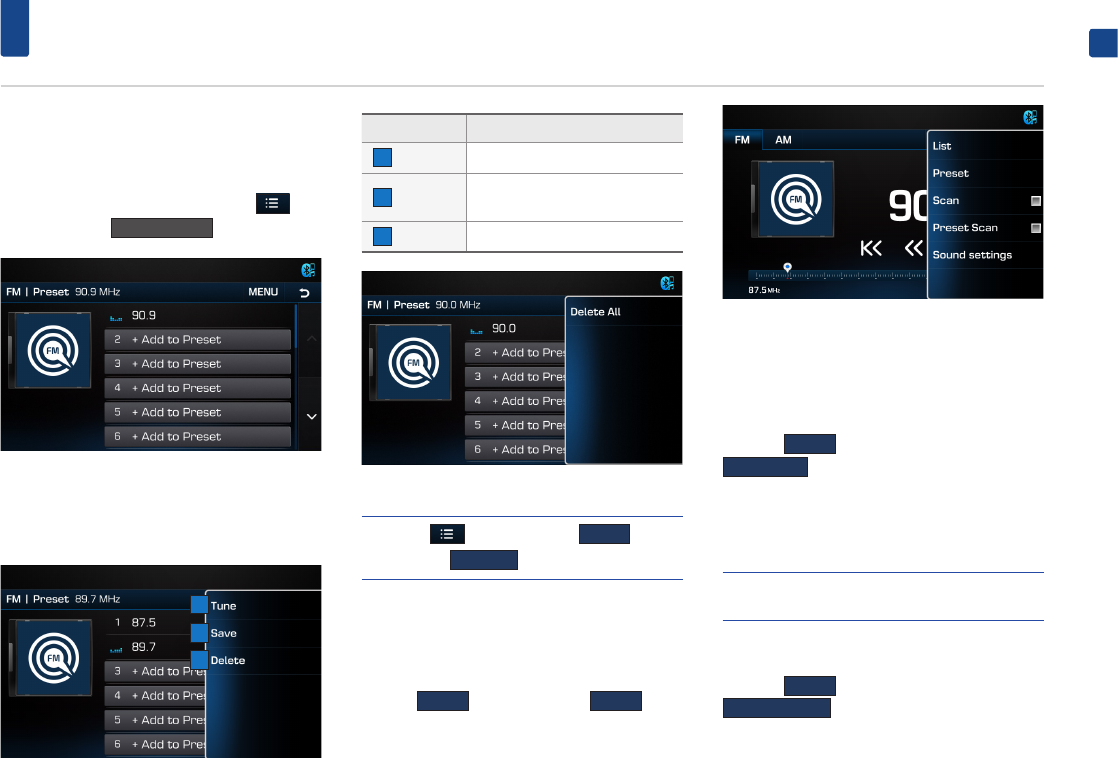
15
FM/AM
ENGLISH
Saving Radio Frequency
Saving Manually
After selecting frequency ▶ Press the but-
ton ▶ Press the
+ Add to Preset
.
Using Preset Menu
Press and hold the preset list you want to edit.
Name Description
1 Tune listens to frequency selected.
2 Save overwrites frequency listening
to currently.
3 Delete deletes frequency.
NOTE
• Press the button
▶
Press the
MENU
button
▶
Press the
Delete all
to delete entire presets.
Scan
Scanning Radio Frequency
Press the
MENU
button ▶ Press the
Scan
.
Starting from the current frequency, frequencies
with superior reception are scanned for 3 sec-
onds and the previous frequency is restored.
Scanning Preset frequency
Press the
MENU
button ▶ Press the
Preset Scan
.
Plays frequencies saved to presets for 3 seconds
and moves to the next saved frequency.
NOTE
• When the scan is operating, pressing the controller will
stop the function and return to the stopped station.
Sound settings
Press the
MENU
button ▶ Press the
Sound settings
.
For details, refer to the “Sound” on the page 36.
1
2
3

16
USB
About USB
Connect the USB device after turning on the
engine. The USB device may become damaged
if it is already connected when the ignition is
turned on.
•
•Files that are not standard format files will not
be played.
•
•For MP3/WMA files, only music files with com-
pression rates between 8 Kbps ~ 320 Kbps
can be played.
•
•Heed caution to static electricity when con-
necting/disconnecting external USB devices.
•
•Encoded MP3 Players will not be recognized
when connected as an external device.
•
•When connecting an external USB device, the
device may not properly recognize the USB is
in some states.
•
•Only USB devices formatted as FAT 12/16/32
are supported, and NTFS file system is not
supported.
•
•Some USB devices may not be supported due
to compatibility issues.
•
•Avoid contact between the USB connector
with bodily parts/foreign objects.
•
•Repeated connecting/disconnecting of USB
devices within short periods of time may
result in product malfunction.
•
•Insert USB device after starting the car. If the
car is started while USB device is inserted, it
may damage USB device.
•
•The amount of time required to recognize the
external USB device may differ depending
on the type, size, or file formats stored on the
USB. Such differences in required time are not
indications of malfunction.
•
•The device may not recognize the USB device
if separately purchased USB hubs and exten-
sion cables are being used. Connect the USB
directly with the multimedia terminal of the
vehicle.
•
•When application programs are installed to
specific USBs, files may not properly play.
•
•The device may not operate normally if MP3
Players, cellular phones, digital cameras, or
other electronic devices (USB devices not rec-
ognized as portable disk drives) are connected
with the device.
•
•Charging through the USB may not work for
some mobile devices.
•
•The device may not support normal opera-
tion when using a USB memory type besides
Metal Cover Type USB Memory.
•
•The device may not support normal operation
when using formats such as HDD Type, CF, or
SD Memory.
•
•The device will not support files locked by
DRM (Digital Rights Management).
•
•USB memory sticks used by connecting an
Adaptor (SD Type or CF Type) may not be
properly recognized.
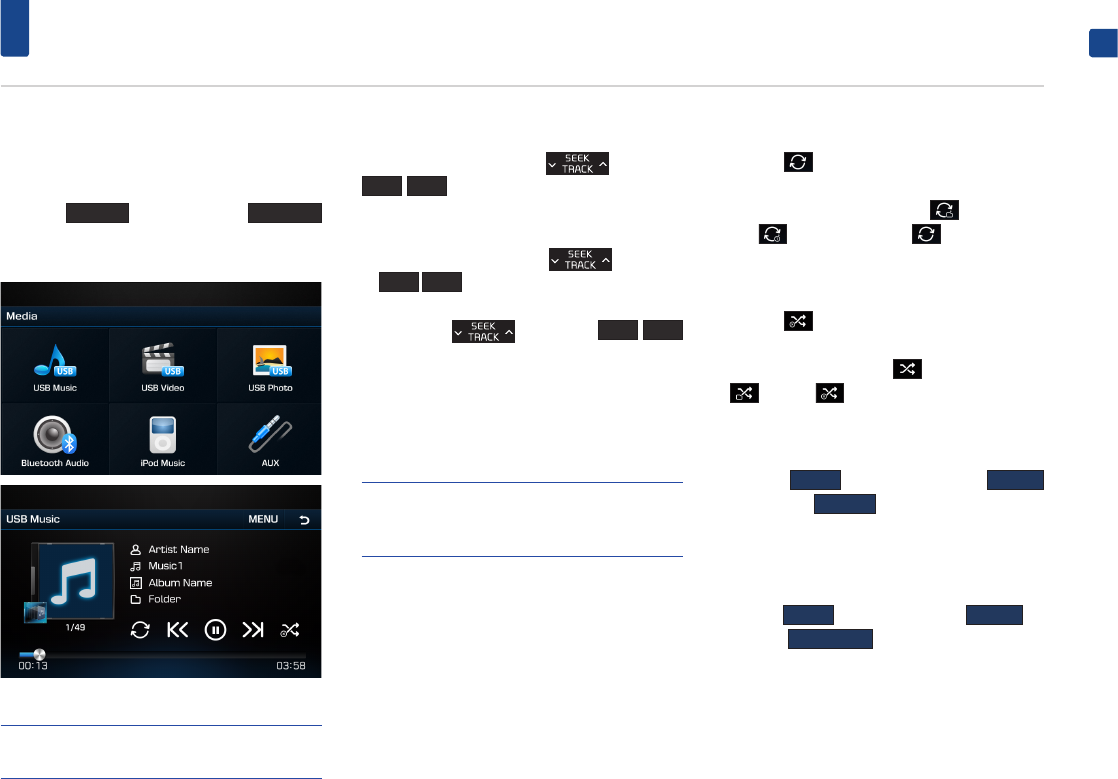
17
USB Music
ENGLISH
Playing USB Music
Once a USB is connected, USB Music mode will
operate automatically.
Press the
MEDIA
key ▶ Press the
USB Music
button▶ Press the Play button to play USB
music.
NOTE
• If the USB is not connected, or there is no media file
in USB then the USB media button will be disabled.
Searching USB Music Files
While playing ▶ Press the key or the
l<<
>>l
button to play the previous/next
file.
•
•Pressing and holding the key or the
l<<
>>l
button will rewind or fast forward
the current file.
•
•While the key or the
l<<
>>l
button is being pressed, the track will rewind
or fast-forward at high speeds. Once the key is
released, the USB Music will begin playing at
normal speed.
NOTE
• Press the TUNE / ENTER knob allows you to select
the previous/next file. This key will not rewind or
fast-forward the file.
Repeat
Press the button.
Each time the button is pressed, the option is
changed from Repeat Folder( ) ▶ Repeat
One( ) ▶Off(Repeat All( )).
Shuffle
Press the button.
Each time the button is pressed, the option is
changed from Shuffle All( ) ▶ Shuffle Folder
( ) ▶ Off( ) .
Scan All
Press the
MENU
button ▶ Press the
Options
▶ Press the
Scan All
to scan files within the
USB in random order.
Scan Folder
Press the
MENU
button ▶ Press the
Options
▶
Press the
Scan Folder
to search files within the
current folder.
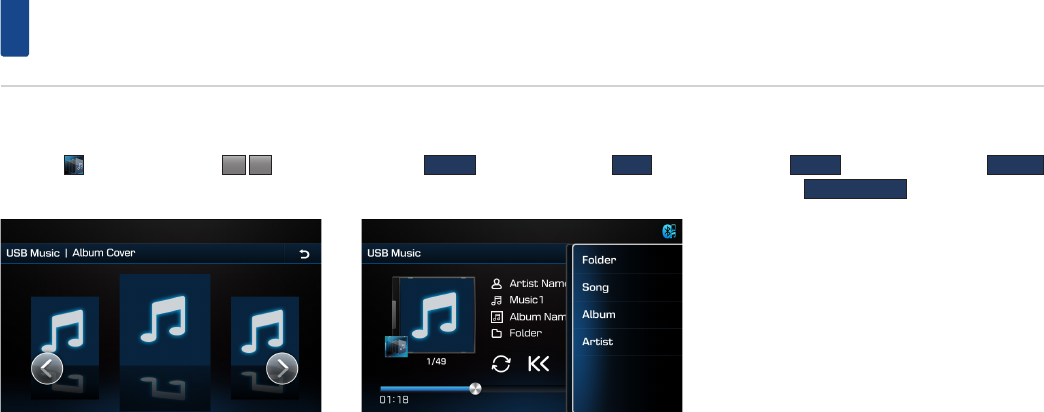
18
USB Music
Album Cover view
Press the button ▶ Press the
<
>
button
to search desired album.
List
Press the
MENU
button ▶ Press the
List
but-
ton to display USB Music list screen.
It is possible to search by Folder, Song, Album
and Artist.
Sound settings
Press the
MENU
button ▶ Press the
Options
▶ Press the
Sound settings
.
For details, refer to the “Sound” on the page 36.
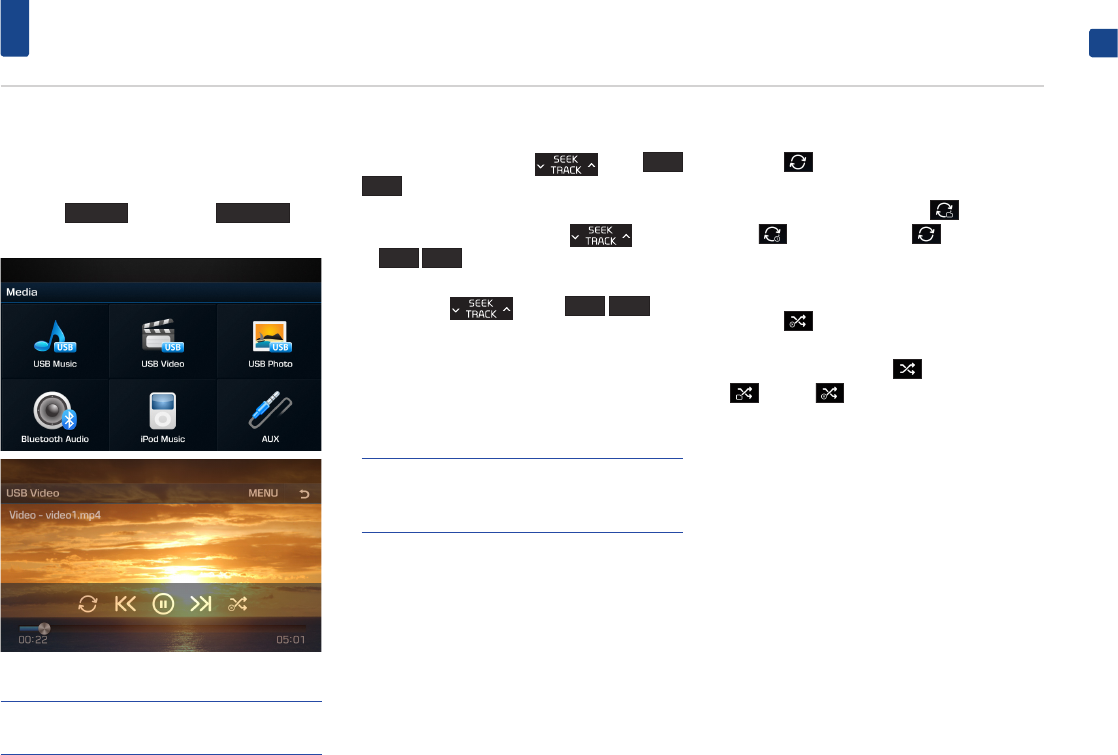
19
USB Video
ENGLISH
Playing USB Video
Once a USB is connected, USB Video mode will
operate automatically.
Press the
MEDIA
key ▶ Press
USB Video
but-
ton ▶ Press the Play button to play USB Video.
NOTE
• If the USB is not connected, or there is no media file
in USB then the USB media button will be disabled.
Searching USB Video Files
While playing ▶ Press the key or
l<<
>>l
button to play the previous/next file.
•
•Pressing and holding the key or
l<<
>>l
button will rewind or fast forward
the current file.
•
•While the key or
l<<
>>l
but-
ton is being pressed, the track will rewind or
fast-forward at high speeds. Once the key is
released, the USB Video will begin playing at
normal speed.
NOTE
• Press the TUNE / ENTER knob allows you to select
the previous/next file. This key will not rewind or fast-
forward the file.
Repeat
Press the button.
Each time the button is pressed, the option is
changed from Repeat Folder( ) ▶ Repeat
One( ) ▶Off(Repeat All( )).
Shuffle
Press the button.
Each time the button is pressed, the option is
changed from Shuffle All( ) ▶ Shuffle Folder
( ) ▶ Off( ) .
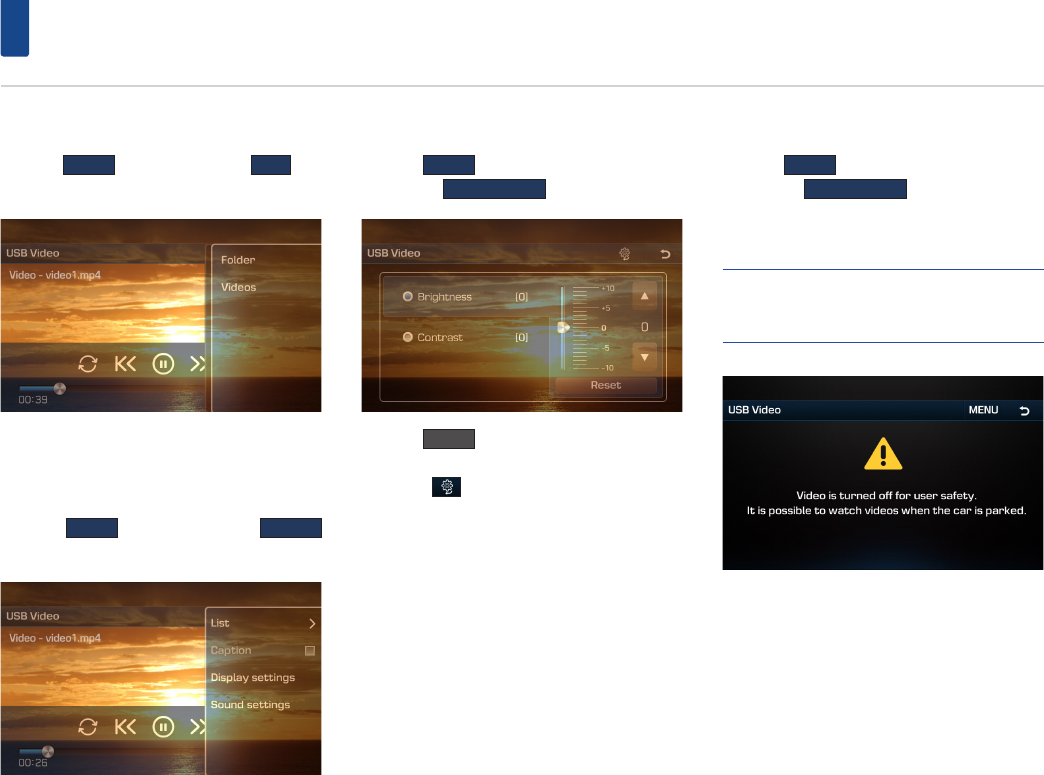
20
USB Video
List
Press the
MENU
button ▶ Press the
List
but-
ton to display USB Video list screen.
It is possible to search by Folder and Videos.
Caption
Press the
MENU
button ▶ Press the
Caption
button to display caption on USB Video screen.
Display settings
Press the
MENU
button
▶ Press the
Display settings
.
Press the
Reset
button to initialize the settings.
Press the button to set “Brightness” and
“Dimming mode”.
For details, refer to the “Display” on the page 37.
Sound settings
Press the
MENU
button
▶ Press the
Sound settings
.
For details, refer to the “Sound” on the page 36.
NOTE
• USB Video is not available while driving.
(Because of traffic regulations, videos is only available
when your vehicle is parked.)
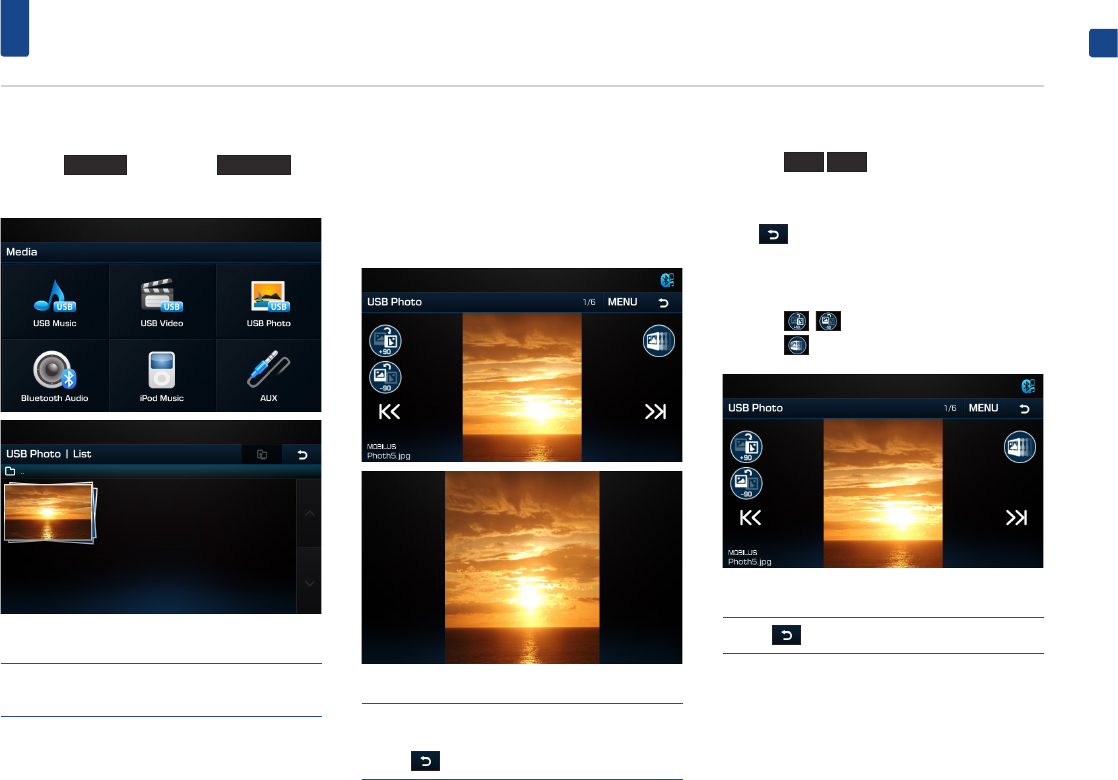
21
USB Photo
ENGLISH
Viewing USB Photo
Press the
MEDIA
key ▶ Press
USB Photo
but-
ton ▶ Press the desired photo in List screen.
NOTE
• If the USB is not connected, or there is no media file
in USB then the USB media button will be disabled.
Switching to menu screen or full
screen
Press the photo to view with full screen.
Press the photo once more to return to the
menu screen.
NOTE
• In full screen, images can be zoomed in/out by up
to 300%.
• Press to move to the List screen.
Searching USB Image Files
Press the
l<<
>>l
button or turn the
TUNE / ENTER knob to view the previous/next
image.
Press to view the list of USB photos.
Rotating / Slide show
Press the buttons to rotate image.
Press the button to view slide show.
NOTE
• Press to move to the previous screen.
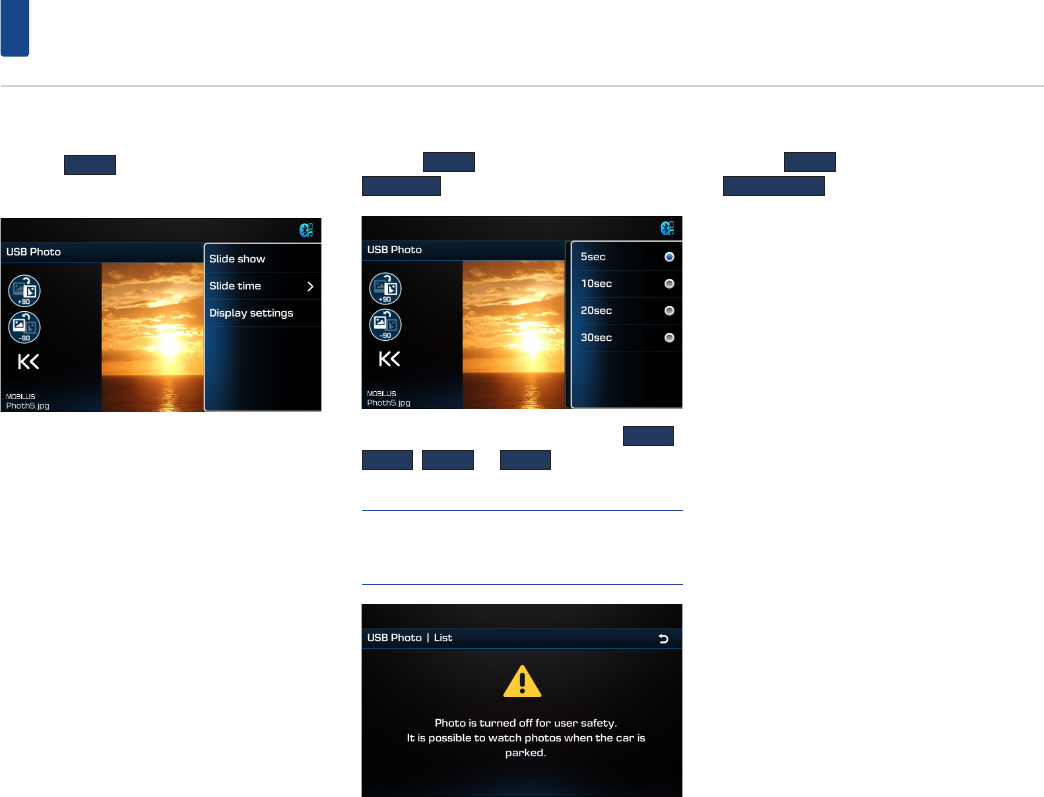
22
USB Photo
Using the Menu Buttons
Press the
MENU
button to set Slide show, Slide
time and Display settings menus.
Slideshow interval
Press the
MENU
button ▶ Press the
Slide time
button.
Slide show intervals can be set at
5 sec
,
10 sec
,
20 sec
, or
30 sec
intervals.
NOTE
• Slideshow is not available while driving.
(Because of traffic regulations, image is only
available when your vehicle is parked.)
Display settings
Press the
MENU
button ▶ Press the
Display settings
button.
For details, refer to the “Display” on the page 37.

23
iPod Music
ENGLISH
About iPod
iPod® is a registered trademark of Apple Inc.
•
•Some iPods with unsupported communica-
tion protocols may not properly operate with
the system.
•
•If the iPod malfunctions due to an iPod device
defect, reset the iPod and try again. (To learn
more, refer to your iPod manual.)
•
•During ACC ON state, connecting the iPod
through the iPod cable (The cable that is sup-
plied when purchasing iPod/iPhone product.)
will charge the iPod through the system.
•
•The use of genuine iPod cables supplied by
Apple is recommended. (The use of other
products may result in noise or abnormal
operation.)
•
•Within iPhones, streaming audio and iPod
control may occasionally conflict. If problems
persist, remove the iPhone and connect again.
•
•Use iPod with complete synchronization to
iTunes. Unauthorized song addition may
cause abnormal operation.
•
•If iPod and Bluetooth are connected simul-
taneously with the same iPhone, you cannot
use Bluetooth audio function.
•
•If iPod touch or iPhone is used, iOS4.2 or a later
version is recommended.
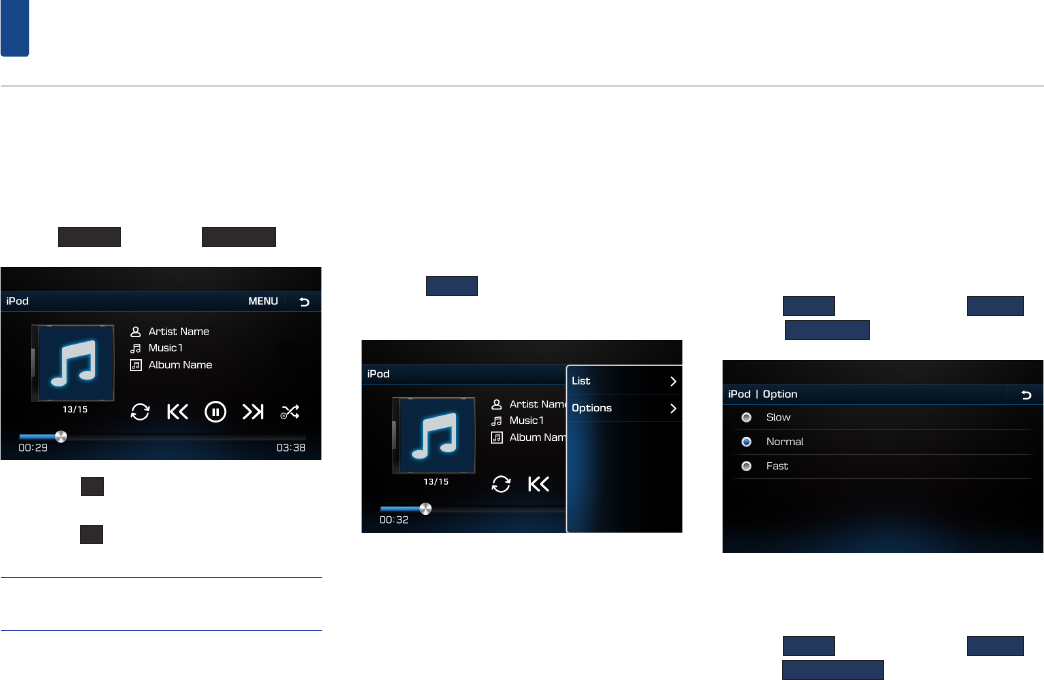
24
iPod Music
Playing iPod Music
Once a iPod is connected, iPod Music mode will
operate automatically.
Press the
MEDIA
key ▶ Press
iPod Music
button.
•
•Press the
▶
button to play files saved within
the iPod device.
•
•Press the
ll
button to pause the file.
NOTE
• If the iPod is not connected, or there is no media file
in iPod then the iPod Music button will be disabled.
Searching iPod Music Files
You can play the previous or next file.
For details, refer to the page 17.
Using the Menu Buttons
Press the
MENU
button to set List and options
menus.
For details, refer to the “List” on the page 18.
Setting audiobook playback speed
Setting the playback speed only affects audio
books purchased from the iTunes store or
audible.com.
For details about iPod, refer to the iPod User
Guide.
Press the
MENU
button ▶ Press the
options
▶
Press the
Audiobook
.
Sound settings
Press the
MENU
button ▶ Press the
options
▶
Press the
Sound settings
.
For details, refer to the “Sound” on the page 36.
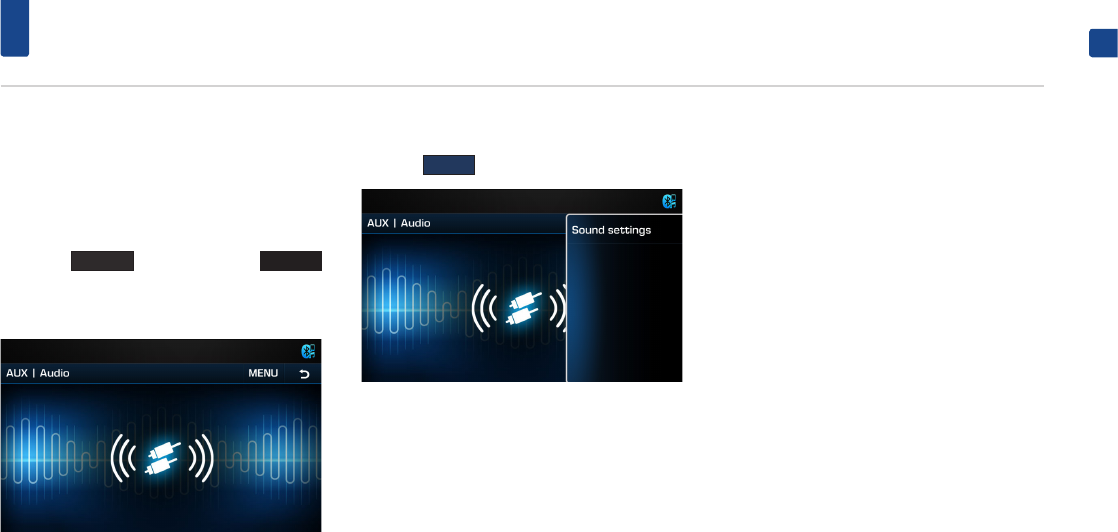
25
AUX
ENGLISH
Playing an AUX source
If an external device connector is connected
with the AUX terminal, then AUX mode will auto-
matically operate.
Press the
MEDIA
key ▶ Press the
AUX
button to play auxiliary device while a different
source is playing.
Using the Menu Buttons
Press the
MENU
button to set Sound.
For details, refer to the “Sound” on the page 36.
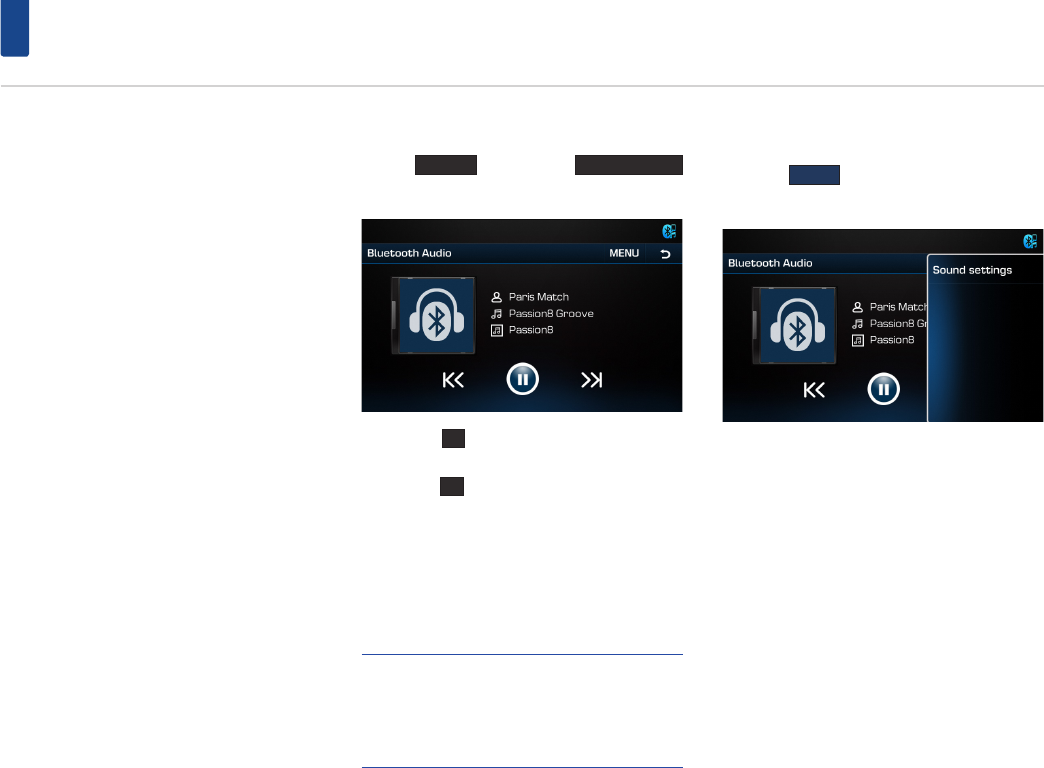
26
Bluetooth Audio
Before playing the Bluetooth
audio
•
•Music saved in the mobile phone can be played
in the car through Bluetooth audio streaming.
•
•Bluetooth audio can be played only when a
Bluetooth phone or Bluetooth audio device
has been connected. To play Bluetooth audio,
connect the Bluetooth phone to the car system.
For more information on connecting Bluetooth,
please refer to the user’s manual [Pairing and
connecting the unit and a Bluetooth phone] on
page 29.
•
•If Bluetooth is disconnected while playing
Bluetooth audio, the audio stream will be inter-
rupted.
•
•The audio streaming function may not be sup-
ported in some mobile phones. Only one func-
tion can be used at a time, either the Bluetooth
handsfree or the Bluetooth audio function. For
example, if you convert to the Bluetooth hands-
free while playing Bluetooth audio, the music
stream is interrupted.
•
•Playing music from the car is not possible when
there are no music files saved in the mobile
phone.
Playing Bluetooth audio
Press the
Media
key ▶ Press the
Bluetooth Audio
button.
•
•Press the
▶
button to play files saved within
the Bluetooth® phone.
•
•Press the
ll
button to pause the file.
Searching Bluetooth audio Files
You can play the previous or next file.
For details, refer to the page 17.
NOTE
• The title/artist info may not be supported in some
mobile phones. When it is not supported, only the
symbol will be displayed.
• The play/pause feature may operate differently
depending on the mobile phone.
Using the Menu Buttons
Press the
MENU
button to set List and Sound
settings menus.
For details, refer to the “Sound” on the page 36.

27
Getting started with navigation
ENGLISH
Precautions for safe driving
Please observe and comply with local traffic
rules and regulations.
•
•For your safety, some features cannot be oper-
ated while driving. Features that cannot be
operated will be disabled.
•
•The route displayed for destination guidance
is a reference and the route guidance will take
you to the vicinity of your destination. The high-
lighted route is not always the shortest distance,
the least congested, and in some cases might,
not be the fastest route.
•
•Road, name, and POI information may not
always been completely updated. It might hap-
pen that road names and POI information is not
up to date.
•
•The car position mark does not always indicate
your exact location. This system uses GNSS
information, various sensors, and road map data
to display the current position. However, errors
in displaying your location may occur if the sat-
ellite is transmitting inaccurate signals or two or
less satellite signals can be received. Errors that
occur in such conditions cannot be corrected.
•
•The position of the vehicle within the navigation
may differ from your actual location depending
on various reasons, including the satellite trans-
mission state, vehicle state (driving location and
conditions), etc. Additionally, the car position
mark may differ from the actual position if the
map data is different from the actual road land-
scape, such as changes due to the construction
of new roads. If such differences occur, driving
for a short period of time will automatically
correct the position of the vehicle through map
matching or GNSS information.
What is GNSS?
The GNSS(Global Navigation Satellite System)
is a satellite-based navigation system made up
of a network of 32 satellites placed into orbit
by the Global Positioning System (GPS) of U.S.A,
GLONASS of RUSSIA, etc.
GNSS works in any weather conditions,
anywhere in the world, 24 hours a day.
There are no subscription fees or setup charges
to use GNSS.
About satellite signals
Your unit must acquire satellite signals to
operate. If you are indoors, near tall buildings
or trees or in a parking garage, the unit cannot
acquire satellite signals.
Acquiring satellite signals
Before the unit can determine your current
position and navigate a route, you must do the
following steps:
1. Go outside to an area free from tall obstructions.
2. Turn on the unit.
Acquiring satellite signals can take a few
minutes.

28
Bluetooth® Wireless Technology
Before Using the Bluetooth
Handsfree
What is Bluetooth®
Wireless Technology?
•
•Bluetooth® Wireless Technology refers to a
short-distance wireless networking technol-
ogy which uses a 2.45GHz frequency to con-
nect various devices within a certain distance.
•
•Supported within PCs, external devices,
Bluetooth® phones, PDAs, various electronic
devices, and automotive environments,
Bluetooth® Wireless Technology to be trans-
mitted at high speeds without having to use a
connector cable.
•
•Bluetooth® Handsfree refers to a device which
allows the user to conveniently make phone
calls with Bluetooth® mobile phones through
the Multimedia system.
•
•The Bluetooth® Handsfree feature may not be
supported in some mobile phones.
Precautions for Safe Driving
•
•Bluetooth® Handsfree is a feature that enables
drivers to practice safe driving. Connecting the
head unit with a Bluetooth® phone allows the
user to conveniently make calls, receive calls,
and manage the phone book. Before using
Bluetooth ® Wireless Technology, carefully read
the contents of this user’s manual.
•
•Excessive use or operations while driving may
lead to negligent driving practices and be the
cause of accidents. Do not operate the device
excessively while driving.
•
•Viewing the screen for prolonged periods of
time is dangerous and may lead to accidents.
When driving, view the screen only for short
periods of time.
Cautions upon Connecting
Bluetooth Phone
•
•Before connecting the head unit with the
mobile phone, check to see that the mobile
phone supports Bluetooth® features.
•
•If you do not want automatic connection with
your Bluetooth® device, turn the Bluetooth®
feature off of the Bluetooth® device.
•
•Park the vehicle when connecting the head
unit with the mobile phone.
•
•Some Bluetooth features may occasionally not
operate properly depending on the firmware
version of your mobile phone. If such features
can be operated after receiving a S/W upgrade
from your mobile phone manufacturer, unpair
all devices and pair again before use.
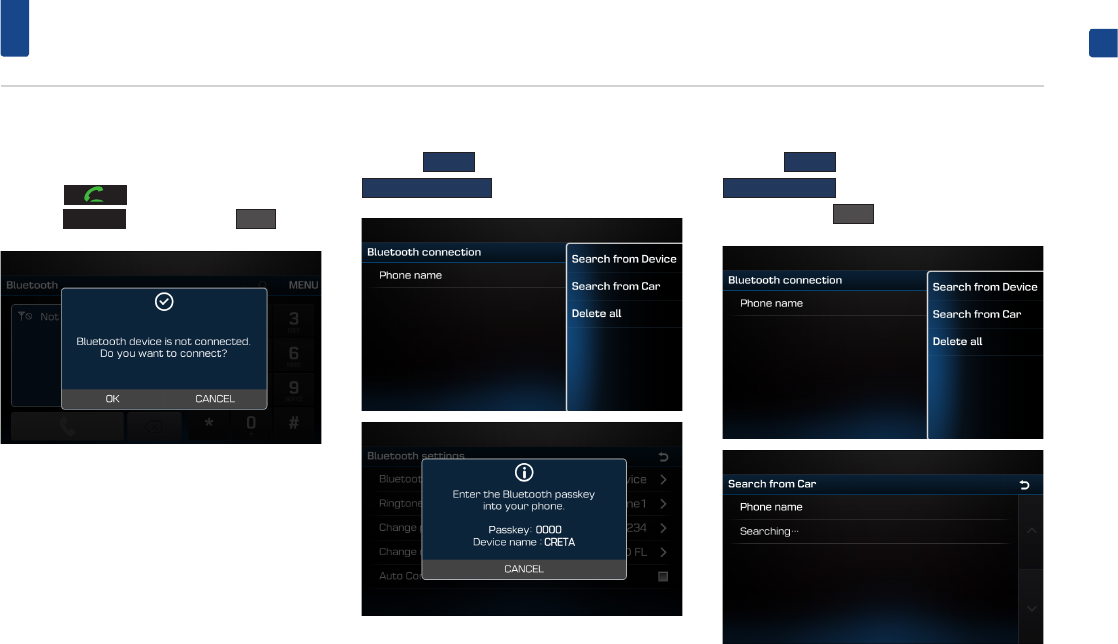
29
Bluetooth Connection
ENGLISH
When no Phones Have Been
Paired
Press the key on the steering wheel or
press the
PHONE
key ▶ Press the
OK
.
Pairing from the Bluetooth® Device
Press the
MENU
button ▶ Press the
Search from device
.
From the Bluetooth® device, search for the car
name and pair the device. When searching from
the Bluetooth® device, the car name is CRETA
and the default passkey is ‘0000’.
Pairing from the car
Press the
MENU
button ▶ Press the
Search from car
▶ Press the phone name to
pair ▶ Press the
YES
.
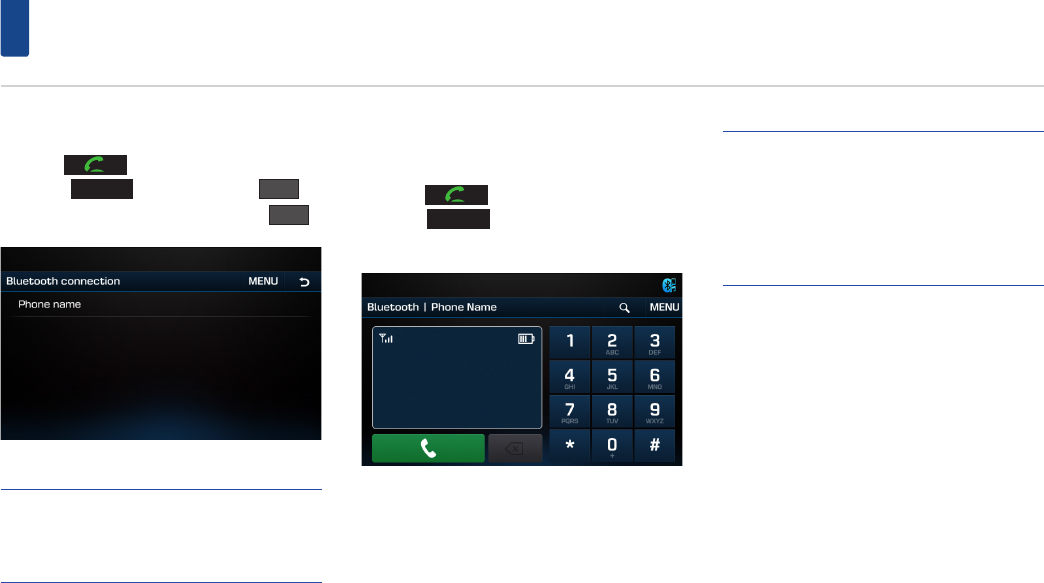
30
Bluetooth Connection
When a Phone is Already Paired
Press the key on the steering wheel or
press the
PHONE
key ▶ Press the
OK
▶
Press the phone name to pair ▶ Press the
YES
.
NOTE
• When a Bluetooth device is connected, a new
device cannot be paired. If you want to pair a new
phone, first disconnect the connected Bluetooth
device.
When your phone is
connected
Press the key on the steering wheel or
press the
PHONE
key on the head unit to dis-
play the following screen.
NOTE
• Once Bluetooth connection is successful, the name
of the connected mobile phone will be displayed
on the phone screen and Bluetooth handsfree
functions will be ready to be operated.
• Some functions may not be supported due to
limited Bluetooth compatibility between the car
system and mobile phone.
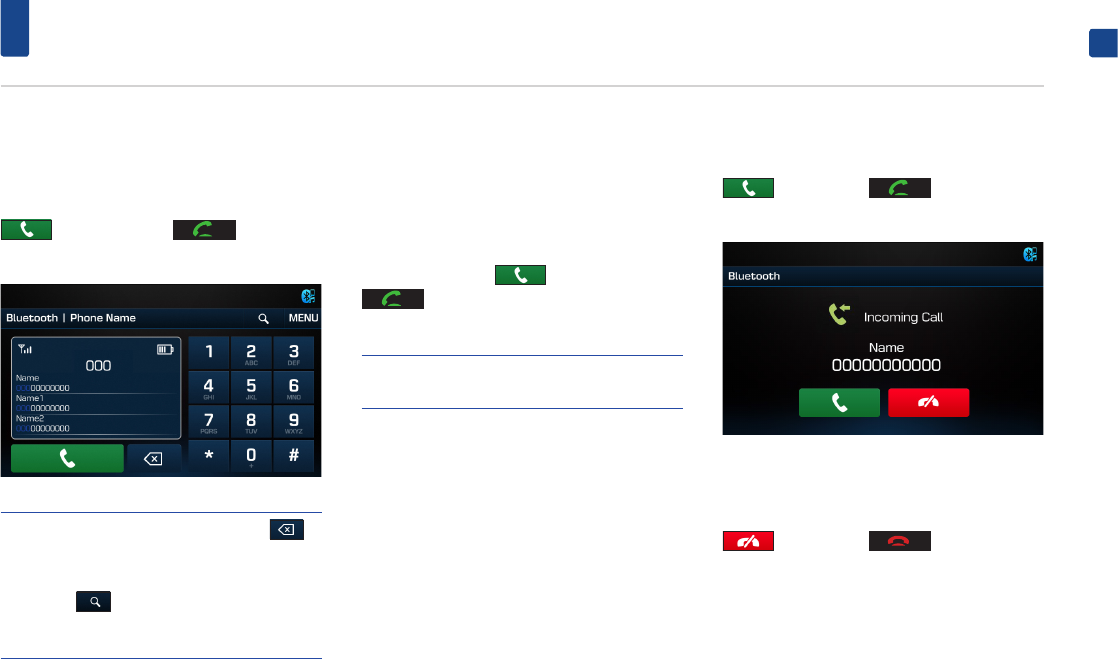
31
Bluetooth Phone
ENGLISH
Making/Answering Calls
Calling by Dialing a Number
Enter number on the Dial Pad ▶ Press the
button or the key on the steer-
ing wheel.
NOTE
• If you press the wrong number, press to
delete one digit of the entered number. Press and
hold the dial pad 0 + to enter a "+".
• Press the button to search phone numbers.
For detail, refer to the “Searching for contacts “ on
the page 33.
Making a Call from Speed Dial
Enter the 1 or 2 digit speed dial number with the
Dial Pad ▶ Press and hold the last number.
Calling through Redial
Press and hold the button or Press the
key on the steering wheel twice.
NOTE
• Redialing is not possible when there is no dialed
calls list.
Answering a Call
Incoming call notice ▶ Press the
button or the key on the
steering wheel.
Rejecting a Call
Incoming call notice ▶ Press the
button or the key on the
steering wheel.
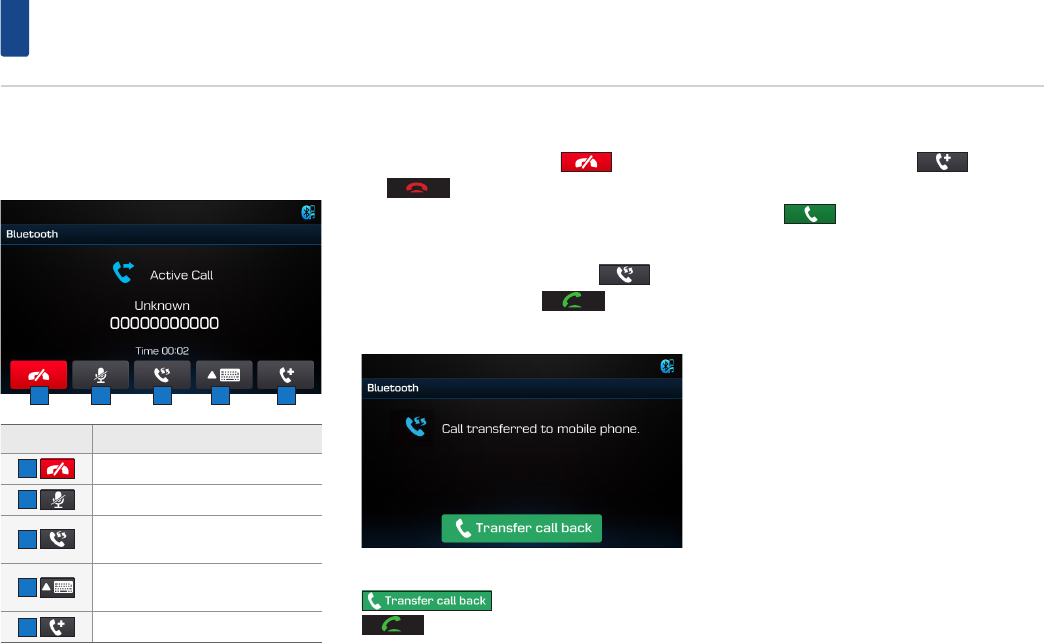
32
Bluetooth Phone
Operating Menus during a
Call
Name Description
1 Ends a call.
2 Turns the Mic On/Off.
3 Switches a voice call from the car
handsfree to the mobile phone.
4 Display dial pad screen for enter-
ing ARS numbers.
5 3 Way call.
Ending a Call
While on a call ▶ Press the button or
the key on the steering wheel.
Switching Call to Bluetooth® Phone
During handsfree call ▶ Press the but-
ton or press and hold the key on the
steering wheel.
During call on mobile phone ▶ Press the
button or press and hold the
key on the steering wheel.
Making 3 way call
While on a call ▶ Press the button. ▶
Press phone number you want to make a call ▶
Press the button.
1 2 3 4 5
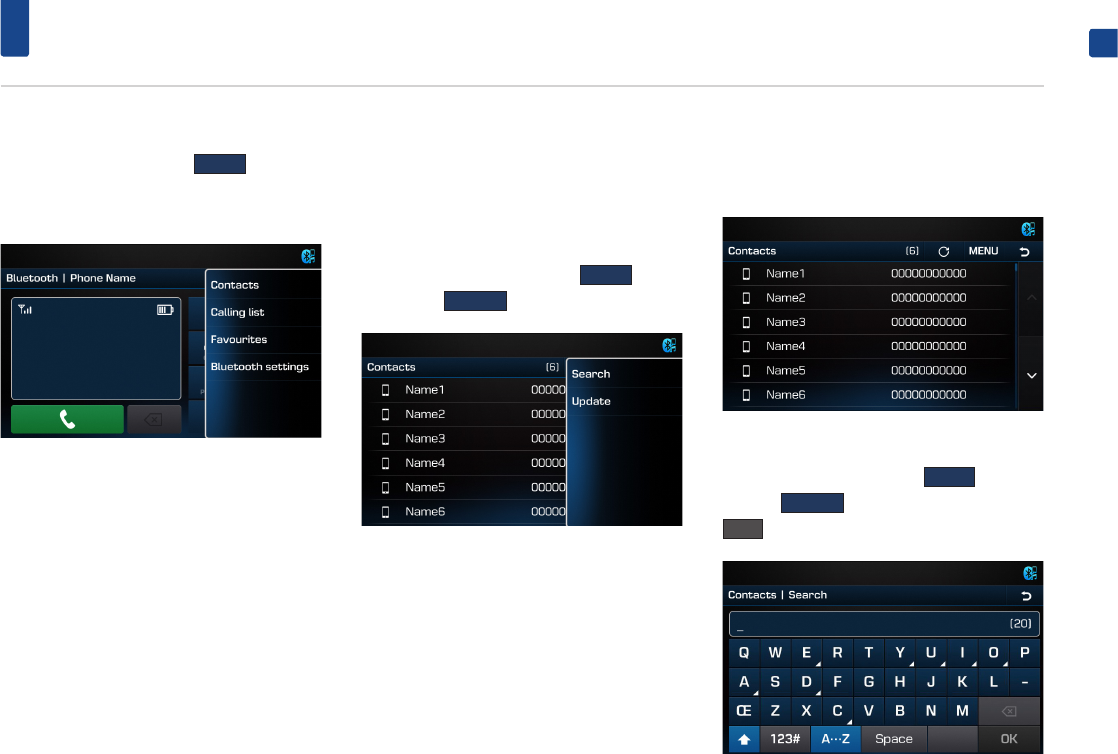
33
Bluetooth Phone
ENGLISH
Using the Menu Buttons
In Phone screen ▶ Press the
MENU
button to
use Contacts , Calling list , Favorites , Bluetooth
settings.
Contacts
Updating Mobile Phone Contacts
Up to 5,000 mobile phone contacts can be
updated.
In Contacts screen ▶ Press the
MENU
button
▶ Press the
Update
.
The contacts are deleted and the contacts
of the connected phone is updated.
Making a call from contacts
In Contacts screen ▶ Press the contact you want
to call.
Searching for contacts
In Contacts screen ▶ Press the
MENU
button ▶
Press the
Search
▶ Enter the name ▶ Press the
OK
▶ Press the contact you want to call.
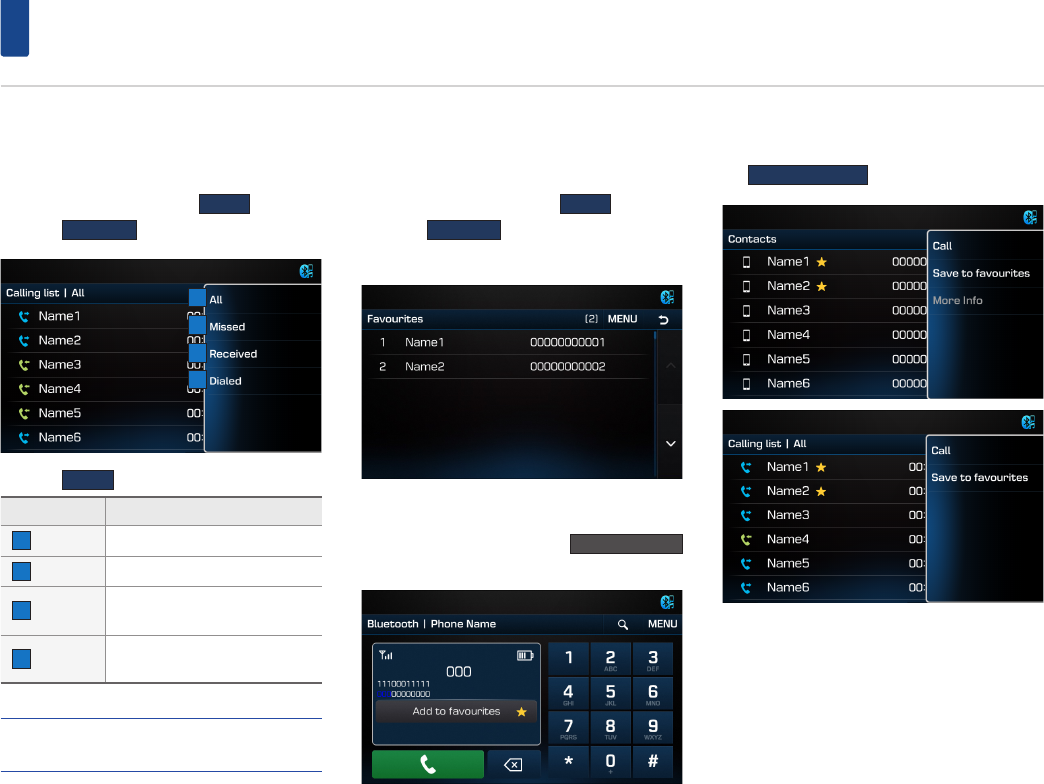
34
Bluetooth Phone
Calling list
Viewing Calling lists
In Phone screen ▶ Press the
MENU
button ▶
Press the
Calling lists
.
Press the
MENU
button on Calling list screen.
Name Description
1 All Displays all calling list.
2 Missed Displays the missed calling list.
3 Received Displays the incoming calling
list.
4 Dialed Displays the outgoing calling
list.
NOTE
• The calling list may not be saved in some mobile
phones.
Favourites
Calling Favourites
In Phone screen ▶ Press the
MENU
button ▶
Press the
Favourites
▶ Press the Favourite you
want to call.
Saving to Favourite
In Phone screen ▶ Press the
Add to favourites
button.
In Contacts screen or Calling list screen ▶ Press
and hold the contact you want to save ▶ Press
the
Save to Favourites
.
1
2
3
4
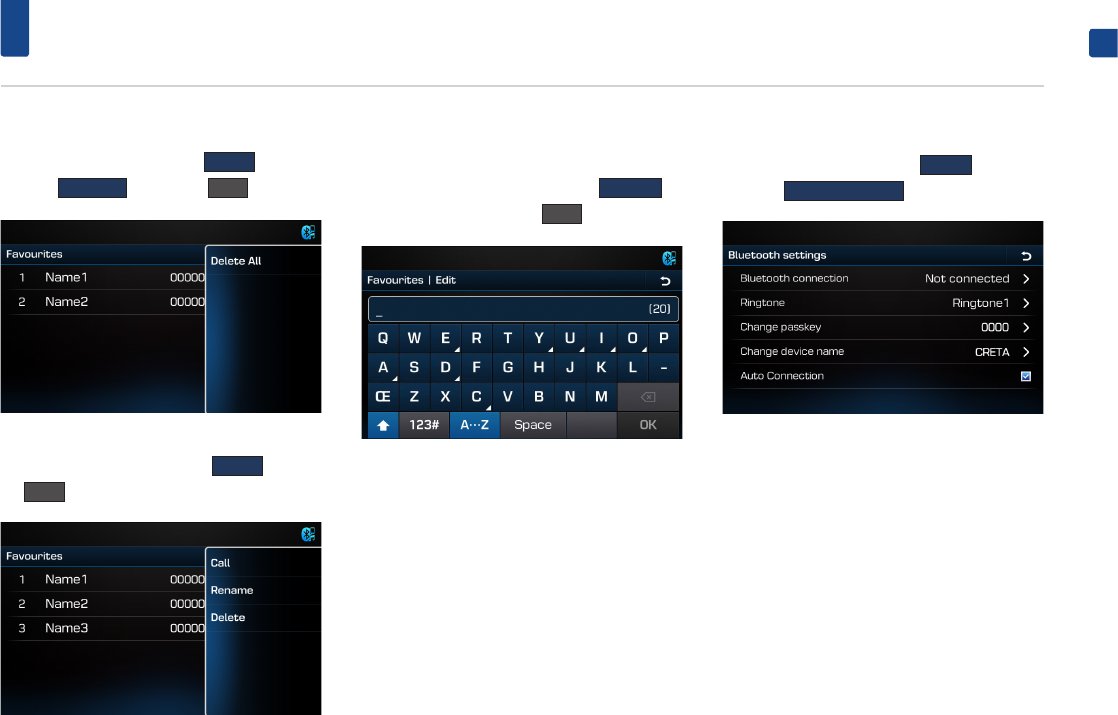
35
Bluetooth Phone
ENGLISH
Deleting Favourites
In Favourites screen ▶ Press the
MENU
button ▶
Press the
Delete all
▶ Press the
OK
.
In Favourites screen ▶ Press and hold the favourite
you want to delete ▶Press the
Delete
▶ Press
the
OK
.
Changing the Favourites name
In Favourites screen ▶ Press and hold the favour-
ite you want to change ▶ Press the
Rename
▶
Enter the name ▶ Press the
OK
.
Bluetooth settings
In Phone screen ▶ Press the
MENU
button ▶
Press the
Bluetooth settings
.
For details, refer to the “Bluetooth” on the page
38.
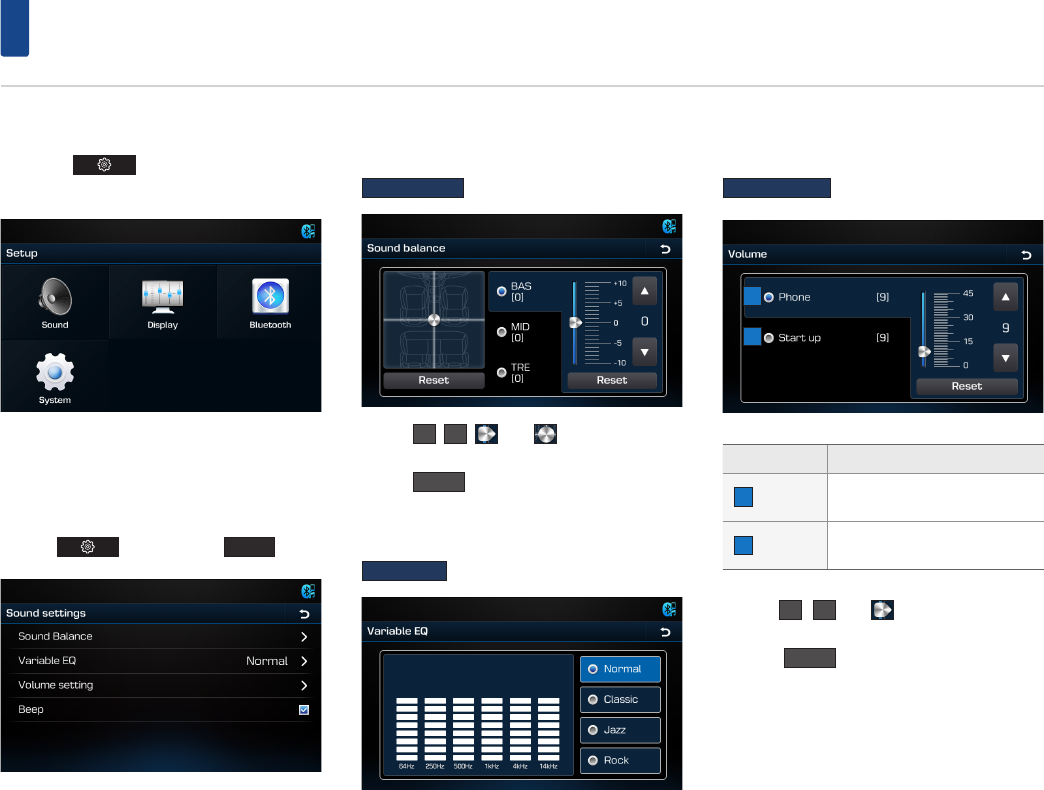
36
Setup
Starting mode
Press the key to display the Setup
screen.
Sound
This menu is used to adjust the sound effects
for the whole system.
Press the key ▶ Press the
Sound
button.
Sound Balance
In Sound settings screen ▶ Press the
Sound Balance
▶ Set the desired sound balance.
Use the
▲
,
▼
, , and buttons to adjust
settings.
Press the
Reset
to restore sound to the center position.
Variable EQ
In Sound settings screen ▶ Press the
Variable EQ
▶ Set the desired mode.
Volume setting
In Sound settings screen ▶ Press the
Volume setting
▶ Set the desired volume.
Name Description
1 Phone Controls the volume related to
phone.
2 Start up Controls the audio volume
when starting the system.
Use the
▲
,
▼
and buttons to adjust set-
tings.
Press the
Reset
to initialize the settings.
1
2
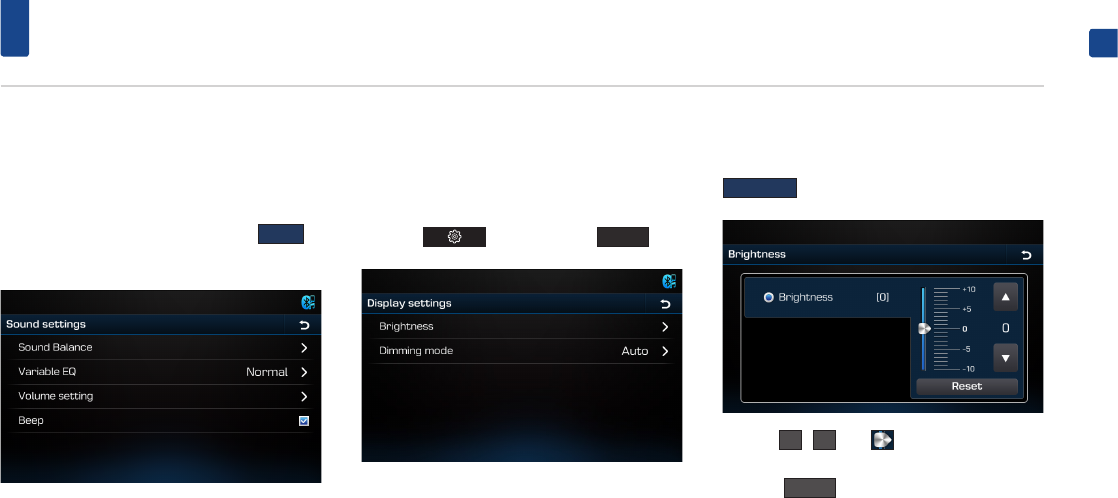
37
Setup
ENGLISH
Beep
This menu allows you to play a beep sound
whenever you operate the touch screen.
In Sound settings screen ▶ Press the
Beep
to
turn on/off.
Display
This menu allows you to adjust the brightness
and set the dimming mode for the whole sys-
tem.
Press the key ▶ Press the
Display
.
Brightness
In Display settings screen ▶ Press the
Brightness
▶ Set the desired brightness.
Use the
▲
,
▼
and buttons to adjust set-
tings.
Press the
Reset
to initialize the settings.
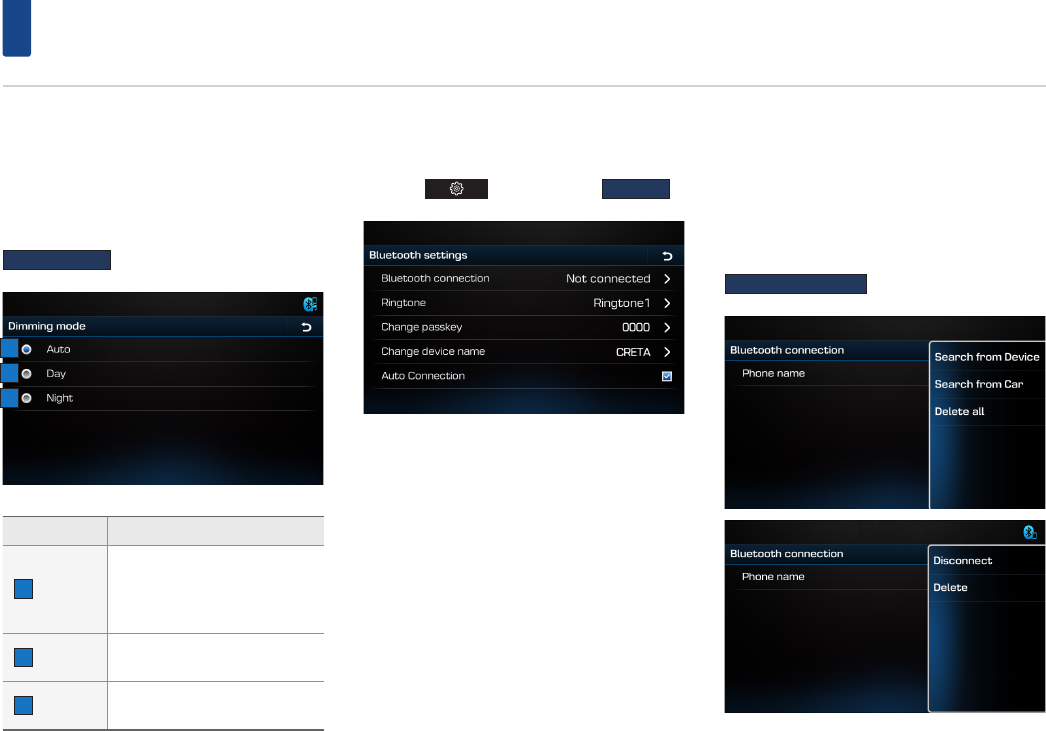
38
Setup
Dimming mode
This menu allows you to set the brightness
according to mode changes.
In Display settings screen ▶ Press the
Dimming mode
▶ Set the desired mode.
Name Description
1 Auto
After selection of auto mode,
two conditions arise.
1. Headlight on → Night mode
2. Headlight off → Day mode
2 Day Brightness level always set on
high.
3 Night Brightness level always set on
low.
Bluetooth settings
This menu allow you to set Bluetooth settings.
Press the key ▶ Press the
Bluetooth
.
Bluetooth connection
This menu allow you to manage the Bluetooth
device list, such as pairing, connecting or delet-
ing Bluetooth devices.
In Bluetooth settings screen ▶ Press the
Bluetooth connection
▶ Set the desired settings.
Press and hold the phone name to disconnect/
delete the device.
1
2
3
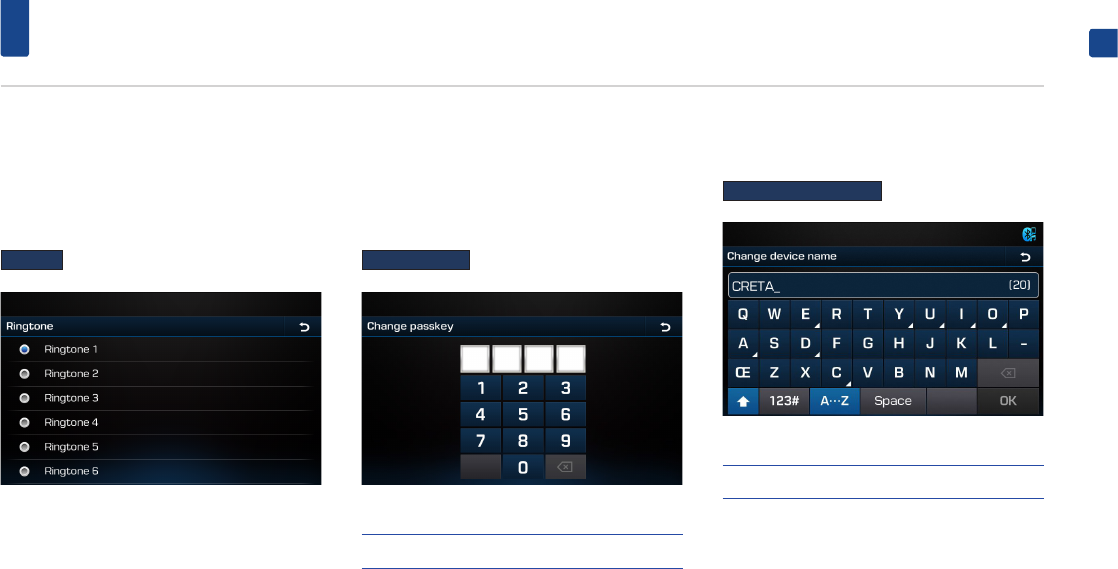
39
Setup
ENGLISH
Ringtone
The configured ringtone is played through the
vehicle speakers when you receive a call.
In Bluetooth settings screen ▶ Press the
Ringtone
▶ Set the desired ringtone.
Change passkey
This feature allows you to change the passkey
used for Bluetooth device authentication.
In Bluetooth settings screen ▶ Press the
Change passkey
▶ Enter the passkey.
NOTE
• The default passkey is 0000.
Changing device name
In Bluetooth settings screen ▶ Press the
Change device name
▶ Enter the name.
NOTE
• The default device name is CRETA .
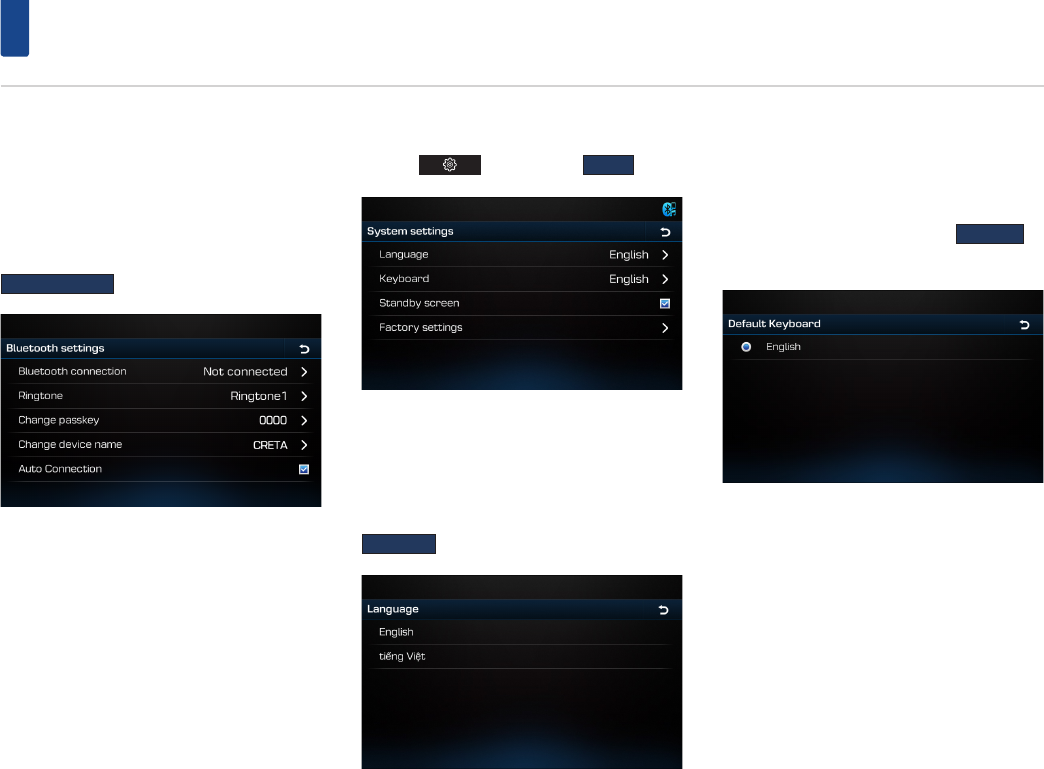
40
Setup
Auto Connection
The Bluetooth® device will automatically be con-
nected according to the option set when the car
ignition is turned on.
In Bluetooth settings screen ▶ Press the
Auto Connection
to turn on/off.
System
Press the key ▶ Press the
System
button.
Language
This menu allows you to set the language of the
system.
In System settings screen ▶ Press the
Language
▶ Press the desired language.
Keyboard
This option allows you to change the type
of keyboard used within the system.
In System settings screen ▶ Press the
Keyboard
▶
Press the desired language.
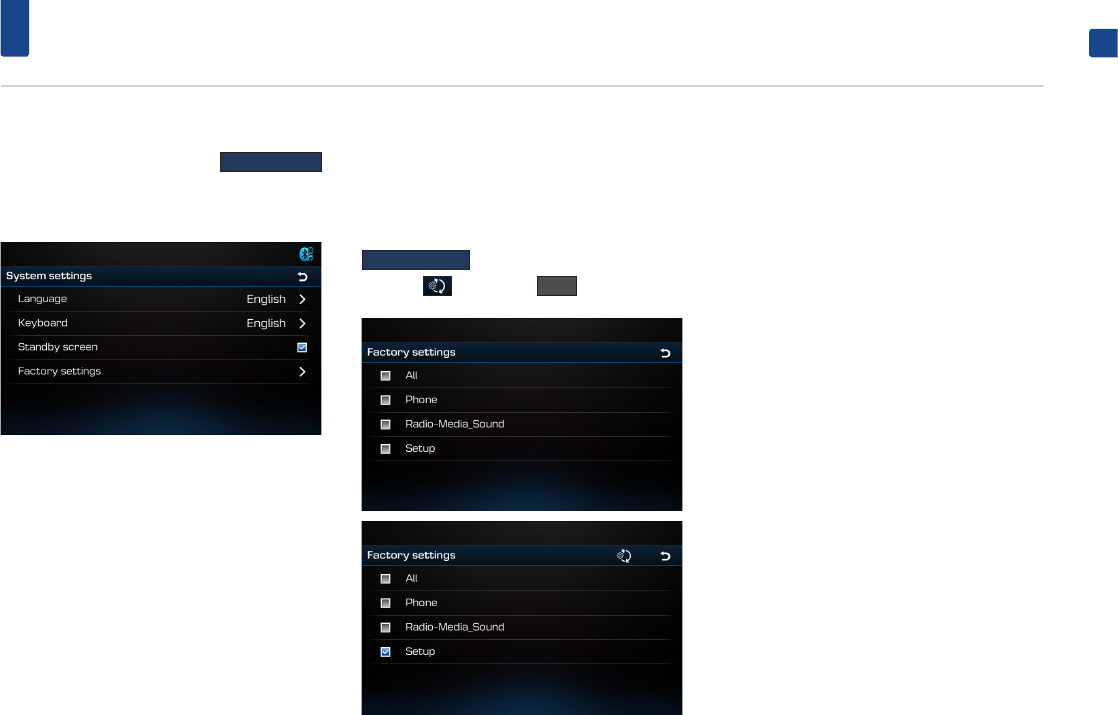
41
Setup
ENGLISH
Standby screen
In System settings screen ▶ Press the
Standby screen
to turns on/off the screen displayed when the system
power is turned off.
Factory settings
This menu allows you to reset settings specified
by the user.
In System settings screen ▶ Press the
Factory settings
▶ Press the desired item ▶
Press the ▶ Press the
YES
.
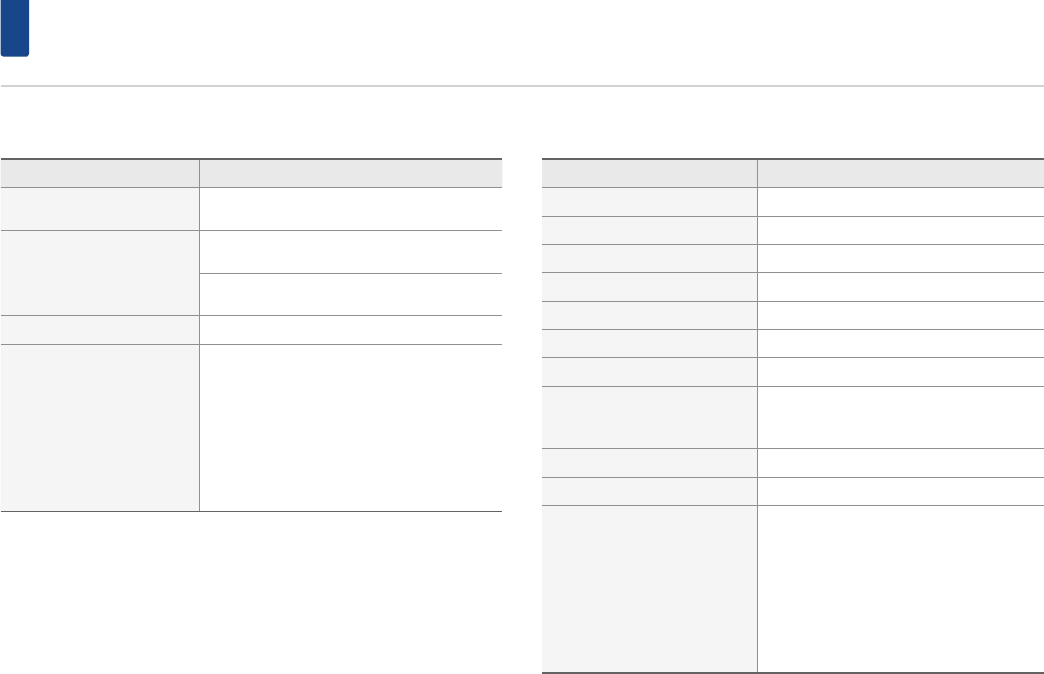
42
Specification
USB MP3 Specification
Category Description
MP3 File Specification Response Specification: MPEG1 AUDIO
LAYER3
Recommended Bitrate and
Sampling Frequency
Response Sampling Frequency : 32, 44.1, 48
(KHz)
Response Bitrate: 32, 40, 48, 56, 64, 80, 96,
112, 128, 160, 192 ,224 ,256 ,320 (Kbps)
ID3 TAG ID3 v1.1 and ID3 v2.x TAG
Detailed Specification
•
•Max Directory Layers: 15 layers
•
•Max length of folder names and file
names: 255Bytes
•
•Characters supported for folder/file
names: English and numbers
•
•Max number of files recognized from one
USB device: 5000
Video and Image Specification
Category Description
File Format AVI(DivX), MPEG
Image Format jpg, gif, bmp, png
Extensions avi, divx, mpg, mpeg, mp4, wmv
Supported Image Resolution Max 4000x3000
Supported Image File Size Max 4 Mbytes
Supported image zoom in/out Max 300%
Video Codec MPEG4-ASP, MPEG4-AVC(H.264), AVS, VP8
Video Resolution
1920 x 1080
(WMV 9: Max 8Mbps, 1280x720,
WMV 8: 640x480)
Audio Codec MP3, OGG, WMA …
Subtitles SMI
Unsupported files
•
•Files not compatible with supported
specifications
•
•Modified files (files with modified file
formats)
•
•Transformed files (example: AVI files
encoded with WMV video codec)
•
•Files without indexes

43
Before thinking there is a product defect
ENGLISH
The current car position as shown on the
navigation may differ from the actual
position under the following conditions.
• When driving on Y-shaped roads with
narrow angles, the current position may
be displayed in the opposite direction.
• Within city streets, the current position
may be displayed on the opposite side or
on an o-road position.
• When changing the zoom level from
maximum to a dierent level, the current
position may become displayed on a
dierent road.
• If the vehicle is loaded onto a ferry or a car
transport vehicle, the current position may
become stalled on the last position prior
to loading.
• When entering a road after passing an
underground parking structure, building
parking structure or roads with many
rotations.
• When driving in heavy trac with frequent
starts and stops.
• When driving under slippery conditions,
such as heavy sand, snow, etc..
• When the tires have recently been
replaced (Especially upon use of spare or
studless tires).
• When using tires of improper size.
• When the tire pressure for the 4 tires are
different.
• When the replacement tire is worn or used
(Especially studless tires having passed a
second season).
• When driving near high-rise buildings.
• When a roof carrier has been installed.
• When a long distance route is calculated
while driving on an expressway, in
such cases, continued driving will
automatically enable the system to
conduct map matching or use updated
GNSS information to provide the current
position (In such cases, up to several
minutes may be required).
Correct route guidance may not occur due
to search conditions or driving position. The
following occurrences are not malfunctions:
• Guidance to go straight may be given
while driving on a straight road.
• Guidance may not be given even when
having turned at an intersection.
• There are certain intersections in which
guidance may not occur.
• A route guidance signaling for a
u-turn may occur in some No u-turn
intersections.
• Route guidance signaling entrance into a
No-entry zone may occur (No-entry zone,
road under construction, etc.).
• Guidance may be given to a position that
is not the actual destination if roads to
reach the actual destination do not exist or
are too narrow.
• Faulty voice guidance may be given if the
vehicle breaks away from the designated
route. (e.g. if a turn is made at an
intersection while the navigation provided
guidance to go straight.)
These situations may occur after conducting
route calculation. The following occurrences
are not malfunctions:
• Guidance may be given to a position
diering from the current position when
turning at an intersection.
• When driving in high speeds, route
recalculation may take a longer period of
time.
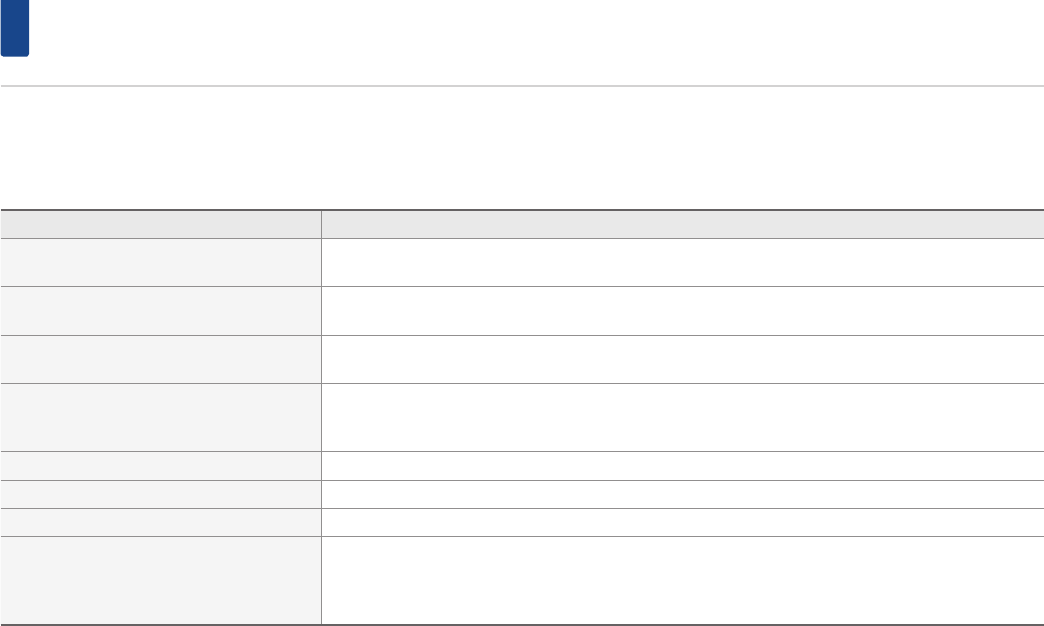
44
Trouble shooting
1. Errors which occur during the operation or installation of the device may be mistaken as a malfunction of the actual device.
2. If you are having problems with the device, try the suggestions listed below.
3. If the problems persist, contact your dealer
Problem Possible Cause
There are small red, blue, or green dots on the
screen
Because the LCD is manufactured with technology requiring high point density, a pixel or lighting deficiency may
occur within 0.01% of total pixels.
The sound or image is not working •
•Has the Switch for the vehicle been turned to [ACC] or [ON]?
•
•Has the SYSTEM been turned OFF?
The screen is being displayed but sound is not
working
•
•Has the volume been set to a low level?
•
•Has the volume been muted?
When the power is turned on, the corners of the
screen are dark
•
•The display appearing somewhat dark after prolonged periods of use is normal with LCD panels. It is not a
malfunction.
•
•If the screen is very dark, contact your nearest dealer for assistance.
Sound is working from only one speaker Are the positions of Fader or Balance sound controls adjusted to only one side?
Sound does not work in AUX mode Are the audio connector jacks fully inserted into the AUX terminal?
The external device is not working Is the external device connected with a standard connector cable?
When turning power on, the most recent mode
screen is not displayed
Within modes that play files by reading external sources, such as USB, iPod, or Bluetooth® streaming mode, the
most recently played mode screen prior to turning off power may not properly load.
•
•If the corresponding device is not connected, the mode operated prior to the most recent mode will operate.
•
•If the previous mode still cannot be properly played, the mode operated prior to that will operate.
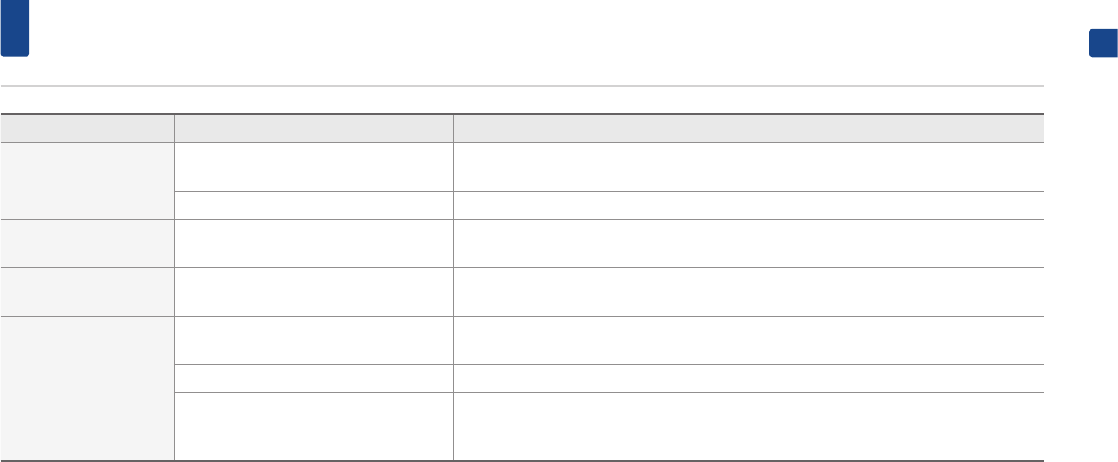
45
Trouble shooting
ENGLISH
Problem Possible Cause Countermeasure
The power does not
turn on.
The fuse is disconnected. •
•Replace with a suitable fuse.
•
•If the fuse is disconnected again, please contact your point of purchase or service center.
Device is not properly connected. Check to see that the device has been properly connected.
The system does not
play. The vehicle battery is low. Charge the battery if the problem persists, contact your point of purchase or service center.
The image colour/ tone
quality is low.
The brightness, and contrast levels are
not set properly. Properly adjust the brightness, and contrast levels through Display Setup.
Sound does not work.
The volume level is set to the lowest
level. Adjust the volume level.
The connection is not proper. Check to see that the device has been properly connected.
The device is currently fast-forwarding,
rewinding, scanning, or playing in slow
mode.
The sound will not work when the device is fast-forwarding, rewinding, scanning, or playing
in slow mode.
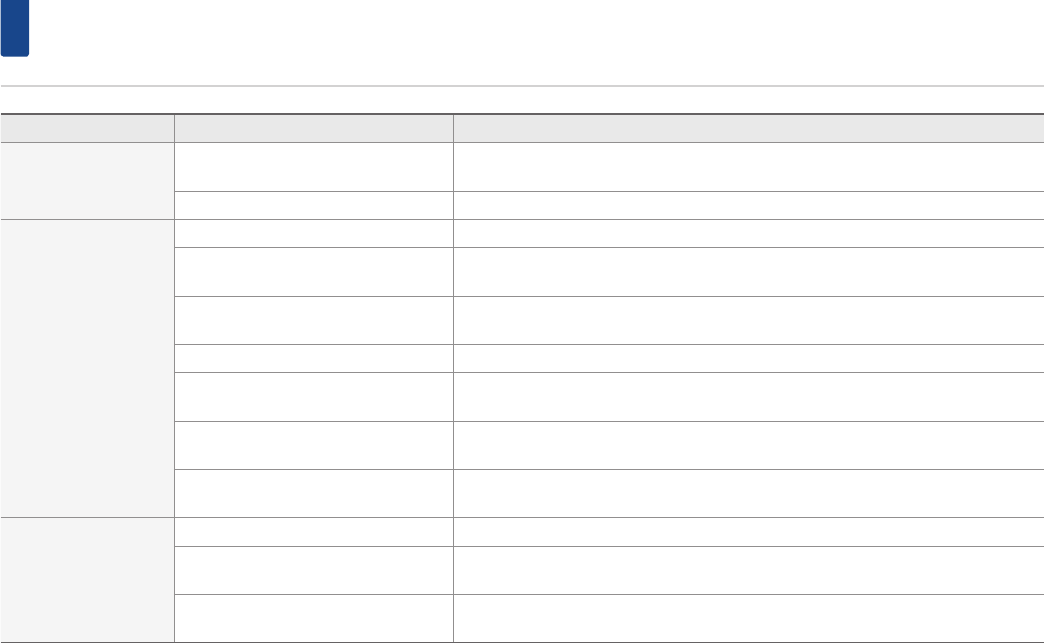
46
Trouble shooting
Problem Possible Cause Countermeasure
The sound or image
quality is low.
Vibration is occurring from where the
conversion switch has been installed. The sound may be short circuited and the image distorted if the device vibrates.
Image colour/tone quality is low. The device will return to normal once vibrations stop.
The USB does not work
USB memory is damaged. Please use after formatting the USB into FAT 12/16/32 format.
USB memory has been contaminated. Remove any foreign substances on the contact surface of the USB memory and multimedia
terminal.
A separately purchased USB HUB is being
used. Directly connect the USB memory with the multimedia terminal on the vehicle.
A USB extension cable is being used. Directly connect the USB memory with the multimedia terminal on the vehicle.
A USB which is not a Metal Cover Type
USB Memory is being used. Use standard USB Memory.
An HDD type, CF, SD Memory is being
used. Use standard USB Memory.
There are no music files which can be
played.
Only MP3, WMA file formats are supported. Please use only the supported music file for-
mats.
The iPod is not rec-
ognised even though it
has been connected
There are no titles which can be played. Use iTunes to download and save MP3 files into the iPod.
The iPod firmware version has not been
properly updated. Use iTunes to update the firmware version and reconnect the iPod with the device.
The iPod device does not recognise
downloads. Reset the iPod and reconnect with the device.

DC Symbol
DC 12 V
Speaker 4 Ω
Puse 10 A
- Minus Ground

FCC Information
This equipment has been tested and found to comply with the limits for a Class В digital device, pursuant to part 15 of the FCC Rules. These limits are
designed to provide reasonable protection against harmful interference in a residential installation.
This equipment generates, uses and can radiate radio frequency energy and, if not installed and used in accordance with the instructions, may cause
harmful interference to radio communications. However, there is no guarantee that interference will not occur in a particular installation. Іf this
equipment does cause harmful interference to radio or television reception, which can be determined by turning the equipment off and on, the user is
encouraged to try to correct the interference by one or more of the following measures:
–Reorient or relocate the receiving antenna.
–Increase the separation between the equipment and receiver.
–Connect the equipment into an outlet on a circuit different from that to which the receiver is connected.
–Consult the dealer or an experienced radio/TV technician for help
This device complies with part 15 of the FCC Rules. Operation is subject to the following two conditions: (1) This device may not cause harmful
interference, and (2) this device must accept any interference received, including interference that may cause undesired operation.
Caution: Any changes or modifications to this device not expressly approved by the party responsible for compliance could void your authority to
operate the equipment.
This equipment complies with FCC radiation exposure limits set forth for an uncontrolled environment.
This equipment should be installed and operated with minimum 20 cm between the radiator and your body. This transmitter must not be collocated or
operating in conjunction with any other antenna or transmitter unless authorized to do so by the FCC.